Sony Group HTS100F Sound Bar User Manual HT S100F
Sony Corporation Sound Bar HT S100F
Contents
- 1. HT-S100F_User Manual_Rev03--Part 01
- 2. HT-S100F_User Manual_Rev03--Part 02
HT-S100F_User Manual_Rev03--Part 01

©2018 Sony Corporation Printed in China 4-727-410-13(1)
http://www.sony.net/
HT-S100F
4-727-410-13(1)
HT-S100F
4-727-410-13(1)
Sound Bar
HT-S100F
Operating Instructions US
Manuel d’instructions FR
Manual de instrucciones ES

2US
HT-S100F
4-727-410-11(1)
Owner’s Record
The model and serial numbers are
located on the bottom of the Bar
Speaker. Record the serial numbers in
the space provided below. Refer to
them whenever you call upon your Sony
dealer regarding this product.
Model No. HT-S100F
Serial No.
To reduce the risk of fire or electric
shock, do not expose this apparatus to
rain or moisture.
The unit is not disconnected from the
mains as long as it is connected to the
AC outlet, even if the unit itself has been
turned off.
To reduce the risk of fire, do not cover
the ventilation opening of the appliance
with newspapers, tablecloths, curtains,
etc.
Do not expose the appliance to naked
flame sources (for example, lighted
candles).
To reduce the risk of fire or electric
shock, do not expose this appliance to
dripping or splashing, and do not place
objects filled with liquids, such as vases,
on the appliance.
As the main plug is used to disconnect
the unit from the mains, connect the
unit to an easily accessible AC outlet.
Should you notice an abnormality in the
unit, disconnect the main plug from the
AC outlet immediately.
Do not install the appliance in a
confined space, such as a bookcase or
built-in cabinet.
CAUTION
Risk of explosion if the battery is
replaced by an incorrect type.
Do not expose batteries or appliances
with battery-installed to excessive
heat, such as sunshine and fire.
Indoor use only.
For the Bar Speaker
The nameplate and date of
manufacture are located on the bottom
of the Bar Speaker.
For the customers in the U.S.A.
The Caution Marking is put on the
Bottom Enclosure (For the Bar Speaker).
This symbol is intended to alert
the user to the presence of
uninsulated “dangerous
voltage” within the product’s
enclosure that may be of sufficient
magnitude to constitute a risk of electric
shock to persons.
This symbol is intended to alert
the user to the presence of
important operating and
maintenance (servicing)
instructions in the literature
accompanying the appliance.
Important Safety Instructions
1) Read these instructions.
2) Keep these instructions.
3) Heed all warnings.
4) Follow all instructions.
5) Do not use this apparatus near
water.
6) Clean only with dry cloth.
WARNING
HT-S100F
4-727-410-11(1)

3US
K:\081\Win7 CS\new\4727410111_HT-S100F_US-CaFR-
LaES\01US\020REG.fm
masterpage:
Right
HT-S100F
4-727-410-11(1)
7) Do not block any ventilation
openings. Install in accordance with
the manufacturer’s instructions.
8) Do not install near any heat sources
such as radiators, heat registers,
stoves, or other apparatus (including
amplifiers) that produce heat.
9) Do not defeat the safety purpose of
the polarized or grounding-type
plug. A polarized plug has two
blades with one wider than the
other. A grounding type plug has
two blades and a third grounding
prong. The wide blade or the third
prong are provided for your safety. If
the provided plug does not fit into
your outlet, consult an electrician for
replacement of the obsolete outlet.
10) Protect the power cord from being
walked on or pinched particularly at
plugs, convenience receptacles, and
the point where they exit from the
apparatus.
11) Only use attachments/accessories
specified by the manufacturer.
12) Use only with the cart, stand, tripod,
bracket, or table specified by the
manufacturer, or sold with the
apparatus. When a cart is used, use
caution when moving the cart/
apparatus combination to avoid
injury from tip-over.
13) Unplug this apparatus during
lightning storms or when unused for
long periods of time.
14) Refer all servicing to qualified service
personnel. Servicing is required
when the apparatus has been
damaged in any way, such as power-
supply cord or plug is damaged,
liquid has been spilled or objects
have fallen into the apparatus, the
apparatus has been exposed to rain
or moisture, does not operate
normally, or has been dropped.
NOTE:
This equipment has been tested and
found to comply with the limits for a
Class B digital device, pursuant to Part
15 of the FCC Rules. These limits are
designed to provide reasonable
protection against harmful interference
in a residential installation. This
equipment generates, uses and can
radiate radio frequency energy and, if
not installed and used in accordance
with the instructions, may cause
harmful interference to radio
communications.
However, there is no guarantee that
interference will not occur in a particular
installation. If this equipment does
cause harmful interference to radio or
television reception, which can be
determined by turning the equipment
off and on, the user is encouraged to try
to correct the interference by one or
more of the following measures:
– Reorient or relocate the receiving
antenna.
– Increase the separation between the
equipment and receiver.
– Connect the equipment into an outlet
on a circuit different from that to
which the receiver is connected.
– Consult the dealer or an experienced
radio/TV technician for help.
Properly shielded and grounded cables
and connectors must be used for
connection to host computers and/or
peripherals in order to meet FCC
emission limits.
CAUTION
You are cautioned that any changes or
modifications not expressly approved in
this manual could void your authority to
operate this equipment.
US
020REG.fm Page 3 Tuesday, September 12, 2017 2:20 PM

4US
E:\4727410131\4727410131HTS100FUC2\01US\020REG.fm masterpage: Left
HT-S100F
4-727-410-13(1)
This equipment must not be co-located
or operated in conjunction with any
other antenna or transmitter.
This equipment complies with FCC
radiation exposure limits set forth for an
uncontrolled environment and meets
the FCC radio frequency (RF) Exposure
Guidelines. This equipment has very low
levels of RF energy that is deemed to
comply without maximum permissive
exposure evaluation (MPE). But it is
desirable that it should be installed and
operated keeping the radiator at least
20cm or more away from person’s body.
For the customers in Canada
Properly shielded and grounded cables
and connectors must be used for
connection to host computers and/or
peripherals.
This device complies with Industry
Canada’s licence-exempt RSSs.
Operation is subject to the following
two conditions:
This equipment complies with IC
radiation exposure limits set forth for an
uncontrolled environment and meets
RSS-102 of the IC radio frequency (RF)
Exposure rules. This equipment should
be installed and operated keeping the
radiator at least 20cm or more away
from person’s body (excluding
extremities: hands, wrists, feet and
ankles).
(1) This device may not cause
interference; and
(2) This device must accept any
interference, including interference
that may cause undesired operation
of the device.
010COV.book Page 4 Friday, October 20, 2017 7:34 PM
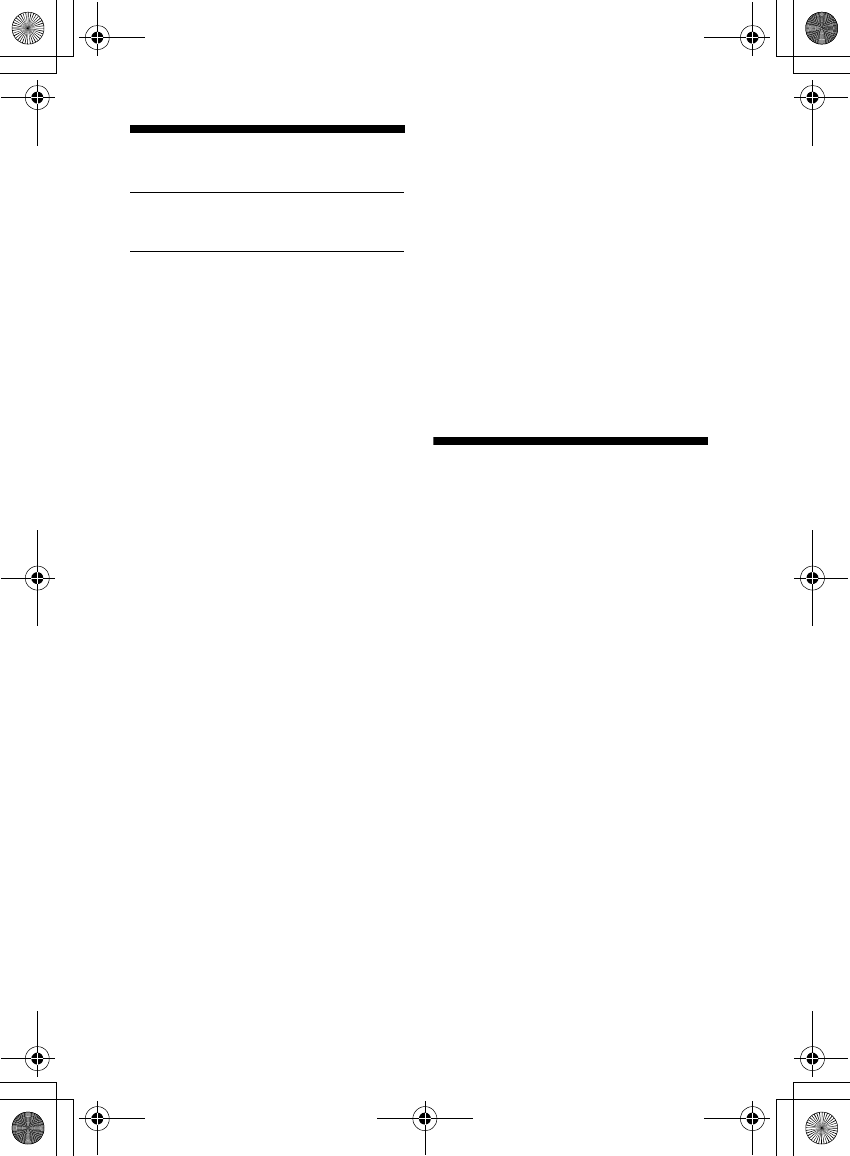
5US
K:\081\Win7 CS\new\4727410111_HT-S100F_US-CaFR-
LaES\01US\010COVTOC.fm
masterpage:
Right
HT-S100F
4-727-410-11(1)
Table of Contents
About These Operating
Instructions ..............................5
What’s in the Box ..........................6
What You Can Do with the
System .....................................7
Guide to Parts and Controls ..........8
Preparing for Using the
System
Mounting the Bar Speaker on a
Wall ........................................ 14
When the TV Remote Control does
not Work ................................ 16
Listening to the Sound
Listening to a TV and Other
Devices ...................................17
Listening to Music on a USB
Device .................................... 18
Selecting the Sound Effect
Adjusting the Sound ....................20
Listening to Music/Sound
with the BLUETOOTH®
Function
Listening to Music from a Mobile
Device .................................... 22
Turning the System On by
Operating the BLUETOOTH
Device ....................................24
Turning the BLUETOOTH Function
Off ..........................................24
Using the Various Functions
Using the Control for HDMI
Function .................................25
Saving Power Consumption ........26
Troubleshooting
Troubleshooting .......................... 27
Resetting the System .................. 31
Additional Information
Specifications ...............................32
Playable Types of Files
(USB Input) .............................34
Supported Input Audio Formats
(HDMI OUT (TV (ARC)) or TV IN
(OPTICAL)) ..............................34
On BLUETOOTH
Communication .....................35
Precautions ..................................36
About These Operating
Instructions
•The instructions in these Operating
Instructions describe the controls on
the remote control.
•Some illustrations are presented as
conceptual drawings, and may be
different from the actual products.
•The default settings are underlined on
each feature description.
Basic Setup
Startup Guide
(separate
document)
010COV.book Page 5 Thursday, September 7, 2017 11:33 AM
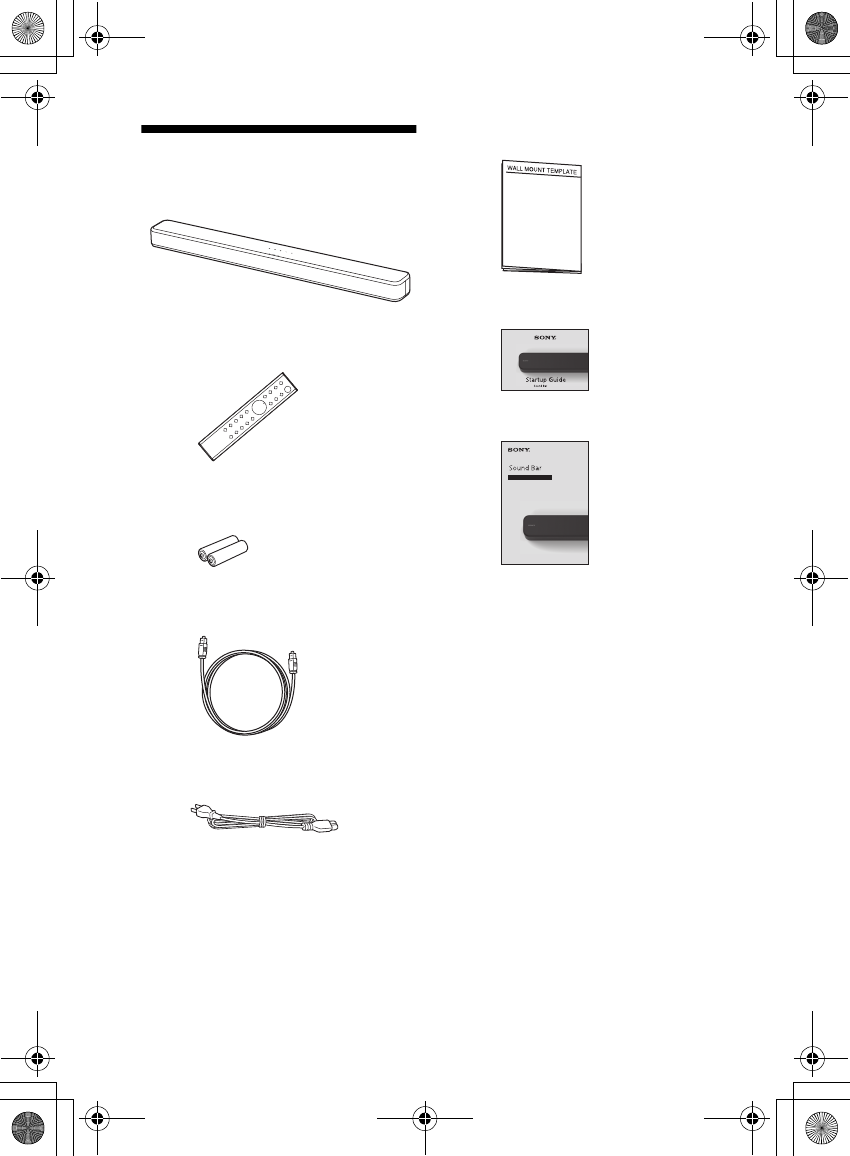
6US
HT-S100F
4-727-410-12(1)
K:\081\Win7 CS\new2\4727410121_HT-S100F__US-FR-
ES\01US\030PAC.fm
masterpage: Left
What’s in the Box
•Bar Speaker (1)
• Remote control (1)
• R03 (size AAA) battery (2)
• Optical digital cable (1)
• AC power cord (mains lead) (1)
• WALL MOUNT TEMPLATE (1)
•Startup Guide
• Operating Instructions
030PAC.fm Page 6 Tuesday, October 10, 2017 11:24 AM

7US
K:\081\Win7 CS\new\4727410111_HT-S100F_US-CaFR-
LaES\01US\030PAC.fm
masterpage:
Right
HT-S100F
4-727-410-11(1)
What You Can Do with the System
“Listening to a TV and Other Devices”
(page 17)
Blu-ray Disc™ player, cable
box, satellite box, etc.
Connecting the TV
(refer to “Startup Guide” (separate
document))
“Using the Control for HDMI Function”
(page 25)
“Listening to Music
on a USB Device”
(page 18)
“Listening to Music from a
Mobile Device” (page 22)
010COV.book Page 7 Thursday, September 7, 2017 11:33 AM

8US
HT-S100F
4-727-410-11(1)
K:\081\Win7 CS\new\4727410111_HT-S100F_US-CaFR-
LaES\01US\030PAC.fm
masterpage: Left
Guide to Parts and Controls
Details are omitted from the illustrations.
Front
Remote control sensor
Point the remote control at the
remote control sensor to operate
the system.
(power) button
Turns on the system or sets it to
standby mode.
(input select) button
(page 17)
BLUETOOTH button (page 22)
+/– (volume) buttons
Indicators
For details, see “About the
indicators on the Bar Speaker”
(page 9).
Bar Speaker
010COV.book Page 8 Thursday, September 7, 2017 11:33 AM

9US
K:\081\Win7 CS\new\4727410111_HT-S100F_US-CaFR-
LaES\01US\030PAC.fm
masterpage:
Right
HT-S100F
4-727-410-11(1)
About the indicators on the Bar Speaker
Lighting and flashing of the indicator(s) on the Bar Speaker indicate the input or
status of the input device.
The indicators flash when turning on/off the function setting or operating the remote
control.
Indicators Status
• Lights: TV input is selected.
• Lights in blue: BLUETOOTH connection is established (BLUETOOTH input is
selected).
• Flashes quickly in blue: While waiting for connection with a device.
• Flashes in blue: While reconnecting or performing pairing.
• Lights: USB input is selected.
• Flashes twice: The play mode is changed.
• Flashes three times first, then flashes slowly repeatedly: When connecting an
unsupported device.
• Flashes repeatedly: While reading data of the connected USB device.
Indicators Status
• Flashes twice: One of the following functions is set to on.
– Night mode (page 20)
– Voice mode (page 20)
• Flashes once: The audio channel is set to Main (page 21), the sound mode is
selected (page 20), or one of the following functions is set to off.
– Night mode (page 20)
– Voice mode (page 20)
• Flashes twice: One of the following functions is set to on.
–Dolby DRC (page21)
– Control for HDMI (page 25)
– BLUETOOTH standby (page 24)
– BLUETOOTH function (page 24)
– Auto standby (page 26)
– IR repeater (page 16)
• Flashes once: The audio channel is set to Sub (page 21) or one of the following
functions is set to off.
–Dolby DRC (page21)
– Control for HDMI (page 25)
– BLUETOOTH standby (page 24)
– BLUETOOTH function (page 24)
– Auto standby (page 26)
– IR repeater (page 16)
• Flash once: The audio channel is set to Main/Sub (page 21).
• Flash quickly: The protection feature is activated (page 30).
• Flash slowly: The system enters standby mode by the auto standby
function (page 26).
010COV.book Page 9 Thursday, September 7, 2017 11:33 AM

10US
HT-S100F
4-727-410-11(1)
K:\081\Win7 CS\new\4727410111_HT-S100F_US-CaFR-
LaES\01US\030PAC.fm
masterpage: Left
The indicators flash while adjusting the volume level.
Tip
You can turn the indicators off by pressing INDICATOR.
Even if the indicators are turned off by pressing INDICATOR, if you operate the system, the
indicators in relation to the operation light or flash.
Indicators Status
• Flashes once: The volume level is low.
• Flash once: The volume level is medium.
• Flash once: The volume level is high.
• Flash repeatedly: The sound is muted.
• Flash twice: The volume level is set to maximum/minimum.
010COV.book Page 10 Thursday, September 7, 2017 11:33 AM

11US
K:\081\Win7 CS\new\4727410111_HT-S100F_US-CaFR-
LaES\01US\030PAC.fm
masterpage:
Right
HT-S100F
4-727-410-11(1)
Rear
AC IN terminal
HDMI OUT (TV (ARC)) jack
Connect a TV that has an HDMI
input jack with an HDMI cable.
The system is compatible with
Audio Return Channel (ARC). ARC
is the function that sends TV
sound to an AV device such as the
system from the TV’s HDMI jack.
(USB) port (page 18)
TV IN (OPTICAL) jack
IR repeater (page 16)
Transmits the remote signal of
the TV remote control to the TV.
010COV.book Page 11 Thursday, September 7, 2017 11:33 AM
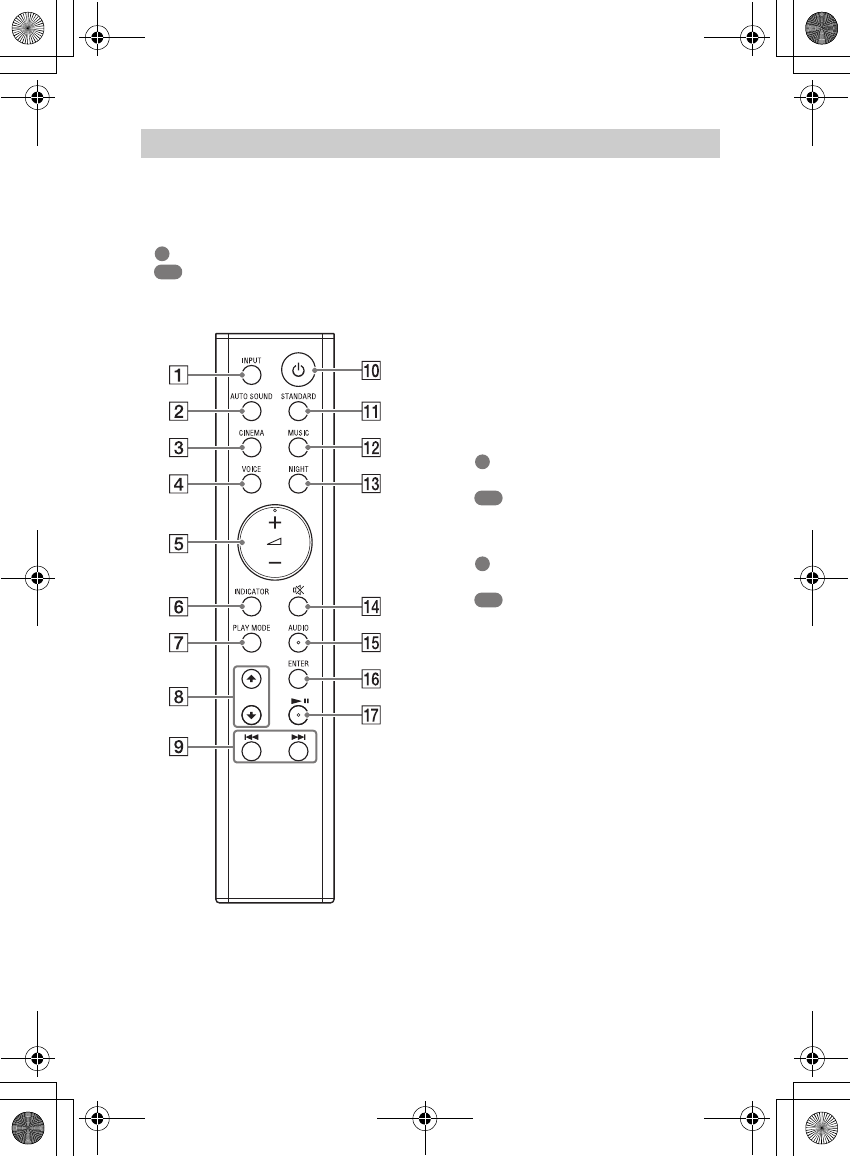
12US
HT-S100F
4-727-410-11(1)
K:\081\Win7 CS\new\4727410111_HT-S100F_US-CaFR-
LaES\01US\030PAC.fm
masterpage: Left
Some buttons function differently
depending on how long the button is
pressed. The icons below indicate how
long to press the button.
• : Press the button.
• : Press and hold the button for 5
seconds.
INPUT (page 17)
Selects the playback source. When
you press INPUT once, the current
input indicator flashes.
Press INPUT again to select the
device you want.
Each time you press INPUT, the
input changes cyclically as follows.
TV input BLUETOOTH input
USB input
AUTO SOUND (page 20)
Selects AUTO SOUND for the sound
effect.
CINEMA
: Selects CINEMA for the sound
effect. (page 20)
: Turns on/off the auto standby
function. (page 26)
VOICE
: Turns on/off the voice mode.
(page 20)
: Turns on/off the Control for
HDMI function. (page 25)
(volume) +*/–
Adjusts the volume.
INDICATOR (page 9)
Turns on/off the indicators on the
Bar Speaker.
PLAY MODE (page 18)
Selects the play mode for USB
playback.
/ (page 18)
Select the content on the TV screen
for USB playback.
Remote Control
010COV.book Page 12 Thursday, September 7, 2017 11:33 AM
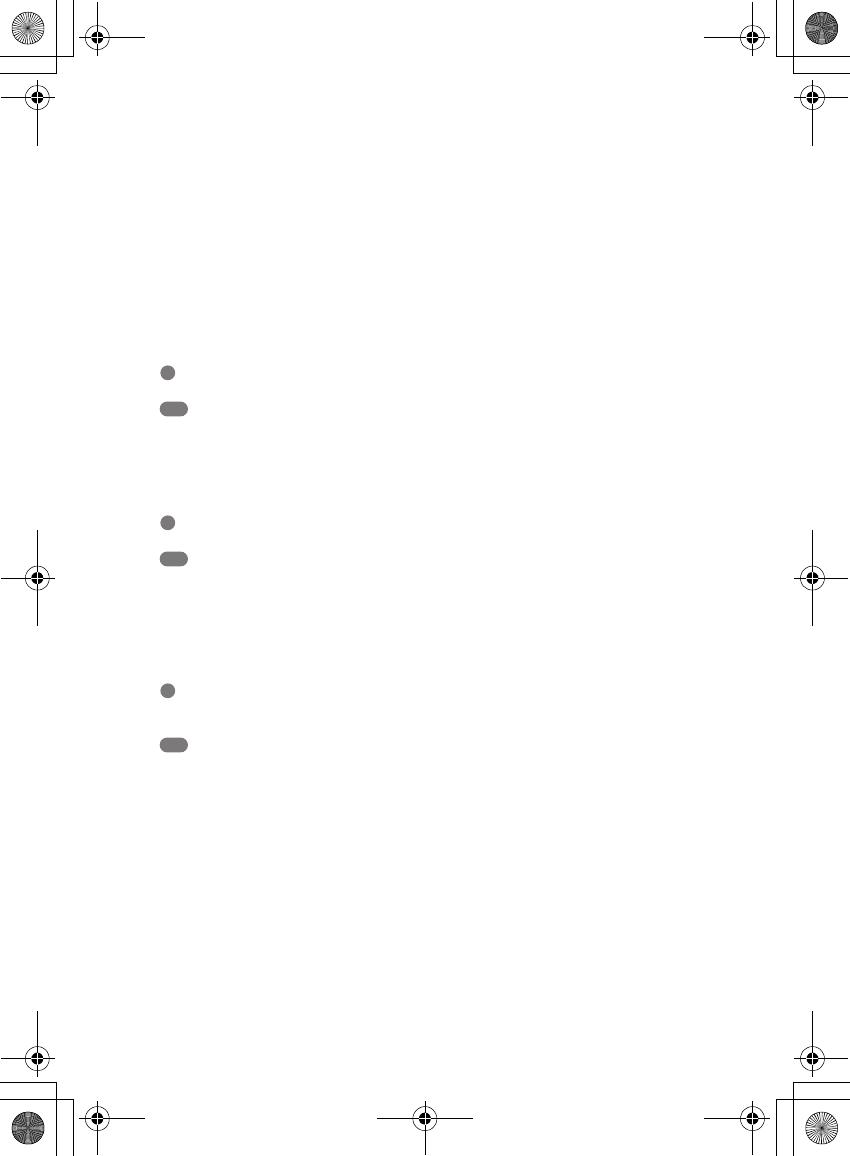
13US
K:\081\Win7 CS\new\4727410111_HT-S100F_US-CaFR-
LaES\01US\030PAC.fm
masterpage:
Right
HT-S100F
4-727-410-11(1)
/ (previous/next)
(page 18, 22)
Pressing the button shortly goes to
the beginning of the previous or
next file.
Pressing and holding searches
backward or forward (rewind/fast
forward).
(power)
Turns on the system or sets it to
standby mode.
STANDARD
: Selects STANDARD for the
sound effect. (page 20)
: Turns on/off the IR repeater
function. (page 16)
MUSIC (page 20)
Selects MUSIC for the sound effect.
NIGHT
: Turns on/off the night mode.
(page 20)
: Turns on/off the BLUETOOTH
standby mode. (page 24)
(muting)
Turns off the sound temporarily or
turn on the sound.
AUDIO*
: Selects the audio channel for
Dolby Digital multiplex broadcast.
(page 21)
: Turns on/off the Dolby DRC
function. (page 21)
ENTER (page 18)
Plays the content that is selected by
/ for USB playback.
(play/pause)* (page 18, 22)
Pauses or resumes playback.
*The AUDIO, +, and buttons have
a tactile dot. Use it as a guide during
operation.
010COV.book Page 13 Thursday, September 7, 2017 11:33 AM
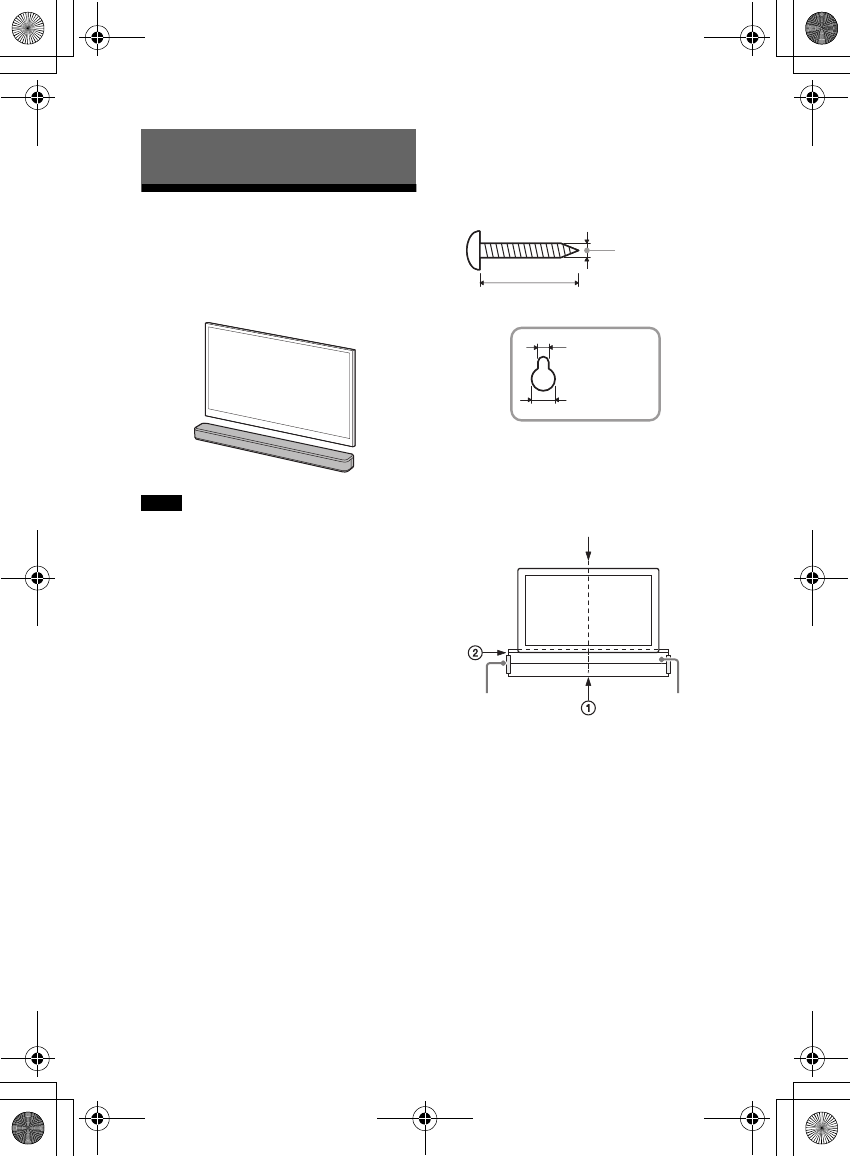
14US
HT-S100F
4-727-410-11(1)
K:\081\Win7 CS\new\4727410111_HT-S100F_US-CaFR-
LaES\01US\040PRE.fm
masterpage: Left
Mounting the Bar
Speaker on a Wall
You can mount the Bar Speaker on a
wall.
•Prepare screws (not supplied) that are
suitable for the wall material and
strength. As a plasterboard wall is
especially fragile, attach the screws
securely in the wall beam. Install the
speakers horizontally, hung by screws in
studs in a continuous flat section of the
wall.
•Have the installation done by a Sony
dealer or licensed contractor and pay
special attention to safety during the
installation.
•Sony shall not be held responsible for
accidents or damage caused by improper
installation, insufficient wall strength,
improper screw installation or natural
disaster, etc.
1Prepare two screws (not supplied)
that are suitable for the wall
mount holes on the rear of the Bar
Speaker.
2Stick WALL MOUNT TEMPLATE
(supplied) on a wall.
1Align TV CENTER LINE () of
WALL MOUNT TEMPLATE with the
center line of your TV.
2Align TV BOTTOM LINE () of
WALL MOUNT TEMPLATE with the
bottom of your TV, then stick
WALL MOUNT TEMPLATE on a
wall by using a commercially
available adhesive tape, etc.
Preparing for Using the System
Notes
Hole on the rear of the Bar Speaker
4mm (3/16 in)
More than 30 mm (1 3/16 in)
5 mm
(7/32 in)
10 mm
(13/32 in)
Center of the TV
WALL MOUNT
TEMPLATE
Adhesive tape,
etc.
010COV.book Page 14 Thursday, September 7, 2017 11:33 AM
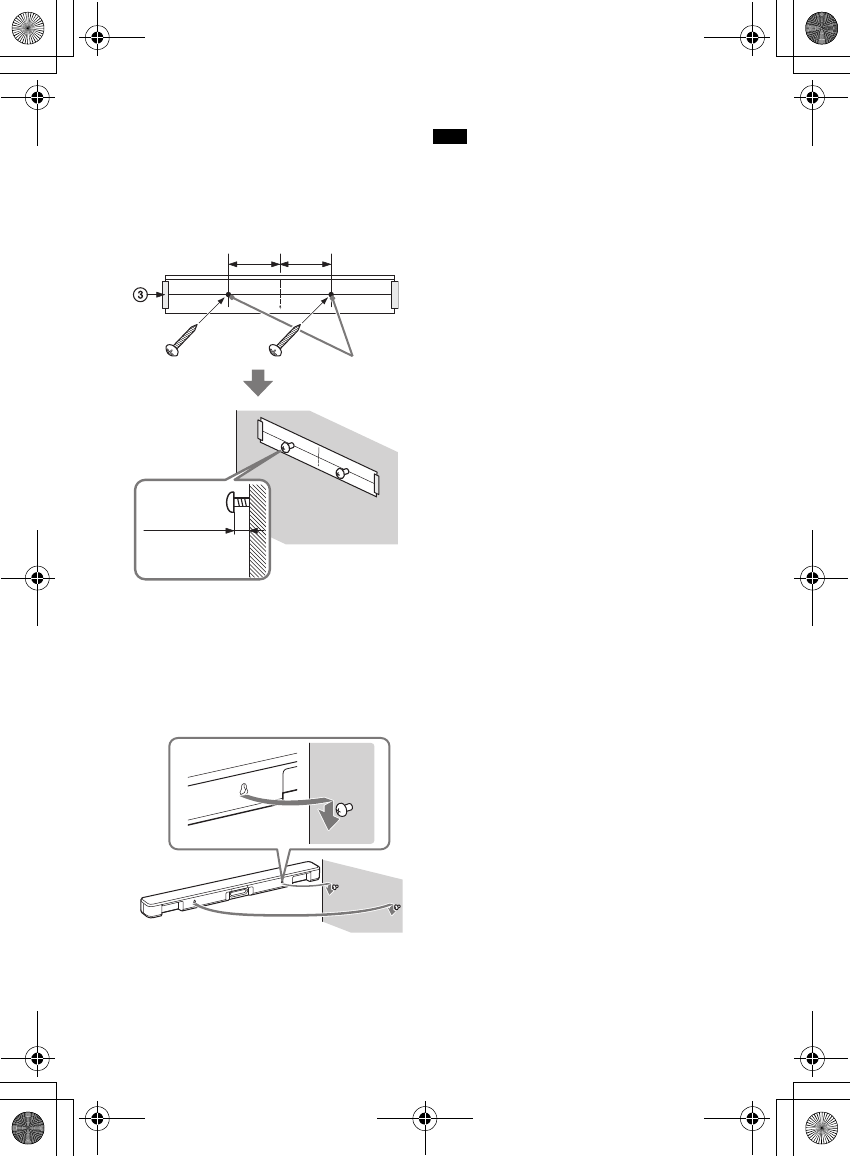
15US
K:\081\Win7 CS\new\4727410111_HT-S100F_US-CaFR-
LaES\01US\040PRE.fm
masterpage:
Right
HT-S100F
4-727-410-11(1)
3Fasten the screws into the marks
on SCREW LINE () of WALL
MOUNT TEMPLATE as the
illustration below.
4Remove WALL MOUNT TEMPLATE.
5Hang the Bar Speaker on the
screws.
Align the holes of the rear of the Bar
Speaker with the screws, then hang
the Bar Speaker on the two screws.
When sticking WALL MOUNT TEMPLATE,
smooth it out fully.
Screws
Marks
6 mm to
7 mm
(approx.
1/4 in)
228.5 mm
(9 in)
228.5 mm
(9 in)
Note
040PRE.fm Page 15 Tuesday, September 12, 2017 4:26 PM

16US
HT-S100F
4-727-410-11(1)
K:\081\Win7 CS\new\4727410111_HT-S100F_US-CaFR-
LaES\01US\040PRE.fm
masterpage: Left
When the TV Remote
Control does not Work
When the Bar Speaker obstructs the
remote control sensor of the TV, the TV
remote control may not work. In that
case, enable the IR repeater function of
the system.
You can control the TV with the TV
remote control by sending the remote
signal from the rear of the Bar Speaker.
Press and hold STANDARD for 5
seconds to set the function to on or
off.
•Be sure to check that the TV remote
control cannot control the TV, and then
set the IR repeater function to on. If it is
set to on when the remote control can
control the TV, appropriate operation
may not be obtained because of the
interference between the direct
command from the remote control and
the command via the Bar Speaker.
•On some TVs, this function may not work
correctly. In this case, place the Bar
Speaker slightly further away from the TV.
IR repeater on
The USB indicator flashes twice.
IR repeater off
The USB indicator flashes once.
Notes
010COV.book Page 16 Thursday, September 7, 2017 11:33 AM
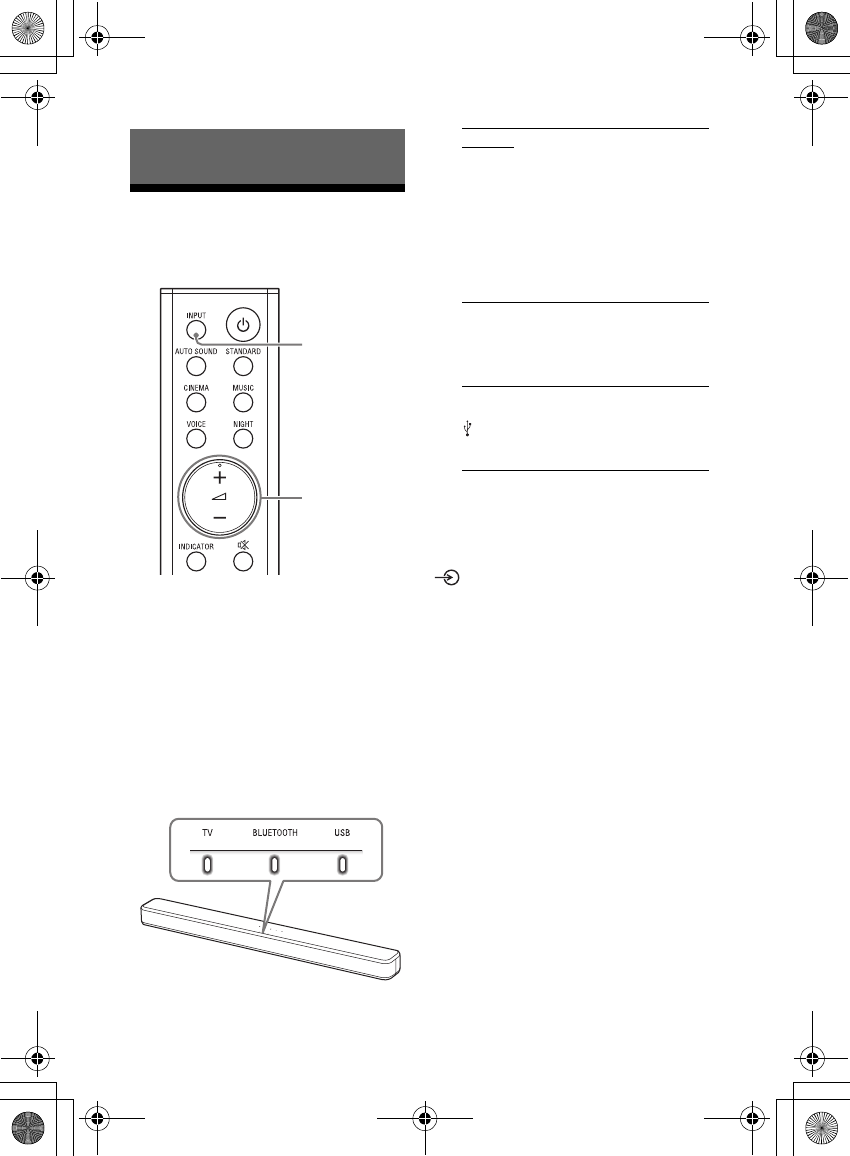
17US
K:\081\Win7 CS\new\4727410111_HT-S100F_US-CaFR-
LaES\01US\050LST.fm
masterpage:
Right
HT-S100F
4-727-410-11(1)
Listening to a TV and
Other Devices
1Press INPUT repeatedly.
When you press INPUT once, the
current input indicator flashes.
Press INPUT again to select the
device you want.
The indicator of the selected device
lights up.
Each time you press INPUT, the
input changes cyclically as follows.
TV input BLUETOOTH input
USB input
2Adjust the volume by pressing
+/– on the remote control.
Tip
You can also select the input by pressing
on the Bar Speaker.
Listening to the Sound
INPUT
+/–
TV input
• TV that is connected to the TV IN
(OPTICAL) jack
• TV compatible with the Audio Return
Channel (ARC) function that is
connected to the HDMI OUT (TV (ARC))
jack
When you connect the TV to both the
HDMI OUT (TV (ARC)) and TV IN
(OPTICAL) jacks, the input of the HDMI
OUT (TV (ARC)) jack has priority.
BLUETOOTH input
BLUETOOTH device that supports A2DP
For details, see “Listening to Music/
Sound with the BLUETOOTH® Function”
(page 22).
USB input
USB device that is connected to the
(USB) port
For details, see “Listening to Music on a
USB Device” (page 18).
010COV.book Page 17 Thursday, September 7, 2017 11:33 AM
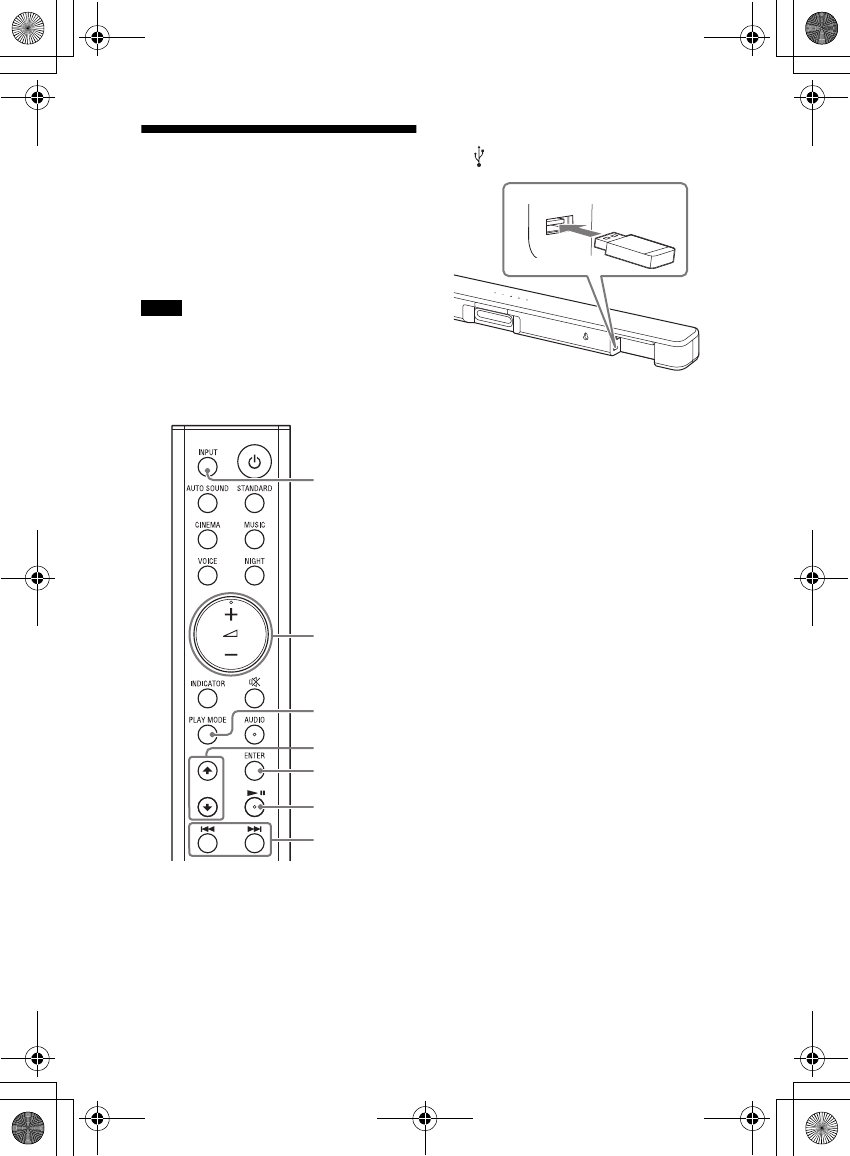
18US
HT-S100F
4-727-410-11(1)
K:\081\Win7 CS\new\4727410111_HT-S100F_US-CaFR-
LaES\01US\050LST.fm
masterpage: Left
Listening to Music on a
USB Device
You can play music files stored on a
connected USB device.
For playable types of files, see “Playable
Types of Files (USB Input)” (page 34).
•To view the USB content list on the TV
screen, make sure you connect the
system to the TV using an HDMI cable.
•Change the input of the TV to the input
which the Bar Speaker is connected.
1Connect the USB device to the
(USB) port.
2Press INPUT repeatedly to select
the USB input.
The USB indicator lights up and the
USB content list appears on the TV
screen.
3Press / to select the content
you want, then press ENTER.
The selected content starts playing.
4Press PLAY MODE repeatedly to
select the play mode you want.
• None: Plays back all tracks.
• [Repeat One]: Repeats one track.
• [Repeat Folder]: Repeats all tracks
in a folder.
• [Shuffle]: Repeats all tracks in a
folder in random order.
The USB indicator flashes twice
each time you press PLAY MODE.
5Adjust the volume by pressing
+/– on the remote control.
Notes
ENTER
PLAY MODE
+/–
/
INPUT
/
010COV.book Page 18 Thursday, September 7, 2017 11:33 AM
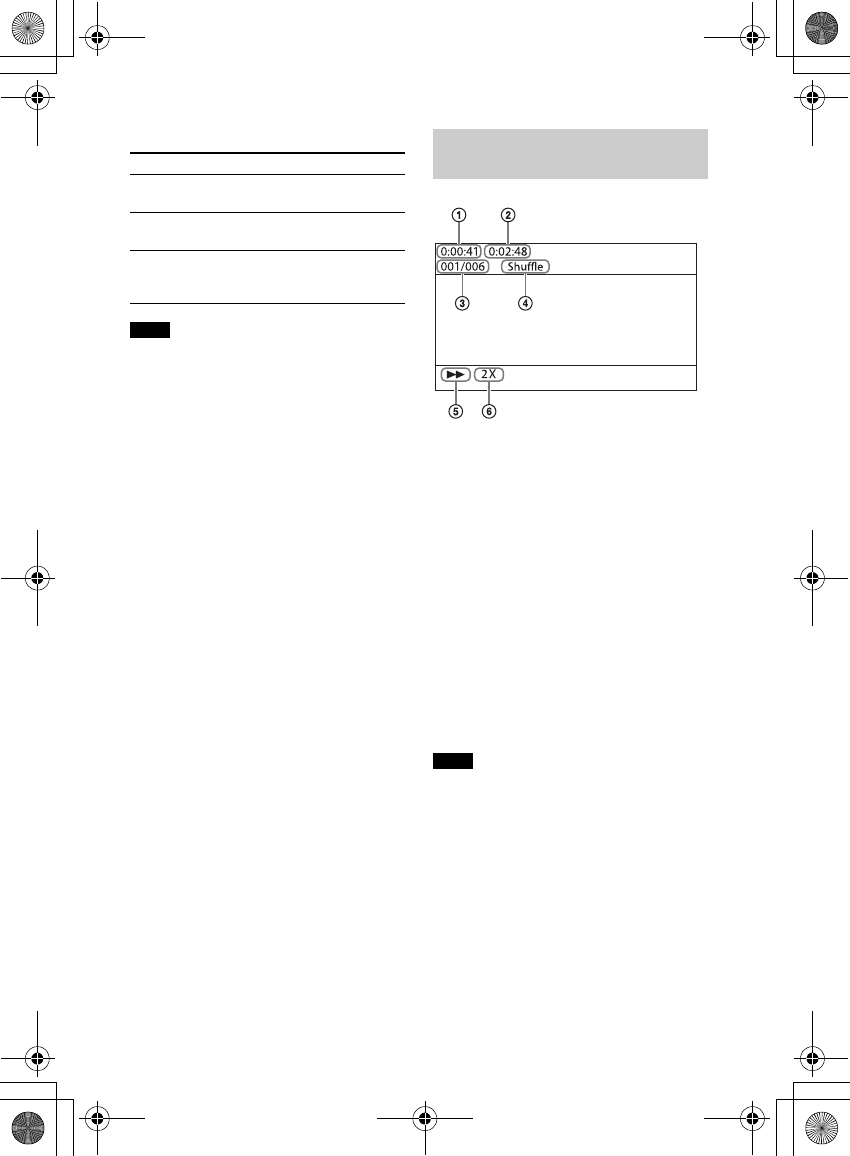
19US
K:\081\Win7 CS\new\4727410111_HT-S100F_US-CaFR-
LaES\01US\050LST.fm
masterpage:
Right
HT-S100F
4-727-410-11(1)
Other operations
•Do not remove the USB device during
operation. To avoid data corruption or
damage to the USB device, turn the
system off before connecting or
removing the USB device.
• The USB indicator flashes three times first,
then flashes slowly repeatedly if you
connect an unsupported USB device.
•Depending on the file format, rewind and
fast forward do not work.
Playing time
Total playing time
Selected file index/Total files in the
folder
Play mode
Playback status
Rewind/fast forward speed
The following messages appear on the
TV screen depending on the status of
the USB device.
•[No USB]
No USB device is inserted.
•[Waiting]
The system is searching a USB device.
• Depending on the playback source, some
information may not be displayed.
• Depending on the play mode, the
information displayed may be different.
To Do this
Pause or resume
playback Press .
Select the previous or
next track Press /.
Search backward or
forward (rewind/fast
forward)
Press and hold
/.
Notes
Information of USB Device
on the TV Screen
Notes
010COV.book Page 19 Thursday, September 7, 2017 11:33 AM
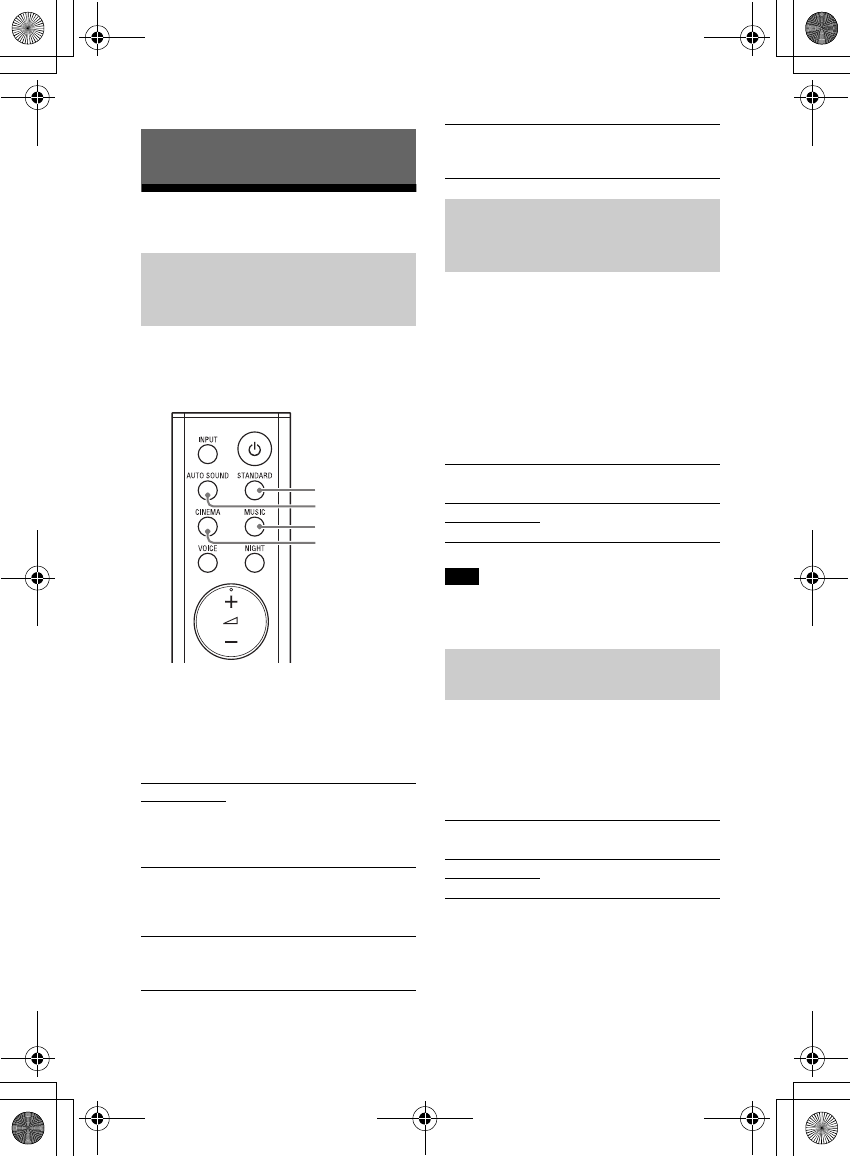
20US
HT-S100F
4-727-410-11(1)
K:\081\Win7 CS\new\4727410111_HT-S100F_US-CaFR-
LaES\01US\060SOU.fm
masterpage: Left
Adjusting the Sound
You can easily enjoy pre-programmed
sound effects that are tailored to
different kinds of sound sources.
Press AUTO SOUND, CINEMA, MUSIC,
or STANDARD to select the sound
mode.
When selecting the sound mode, the TV
indicator flashes once.
You can compress sound in accordance
with the information contained in the
content by setting the night mode to on.
Sound is output at low volume with
minimum loss of fidelity and clarity of
dialogue.
Press NIGHT to set the function to on
or off.
When you turn the system off, the night
mode is set to off automatically.
You can make dialogs clearer by setting
the voice mode to on.
Press VOICE to set the function to on
or off.
Selecting the Sound Effect
Enjoying the Sound Effect
that is Tailored to Sound
Sources (Sound Mode)
AUTO SOUND
You can enjoy the sound with Sony-
recommended sound mode. The sound
mode is automatically optimized according
to playback content and function.
CINEMA
Sounds are played back with surround
effects, and they are realistic and powerful,
making them suitable for movies.
MUSIC
Sound effects are optimized for listening to
music.
STANDARD
AUTO SOUND
MUSIC
CINEMA
STANDARD
Sound effects are optimized for the
individual source.
Enjoying Clear Sound with
Low Volume at Midnight
(NIGHT)
Night mode on
The TV indicator flashes twice.
Night mode off
The TV indicator flashes once.
Note
Making Dialogs Clearer
(VOICE)
Voice mode on
The TV indicator flashes twice.
Voice mode off
The TV indicator flashes once.
010COV.book Page 20 Thursday, September 7, 2017 11:33 AM
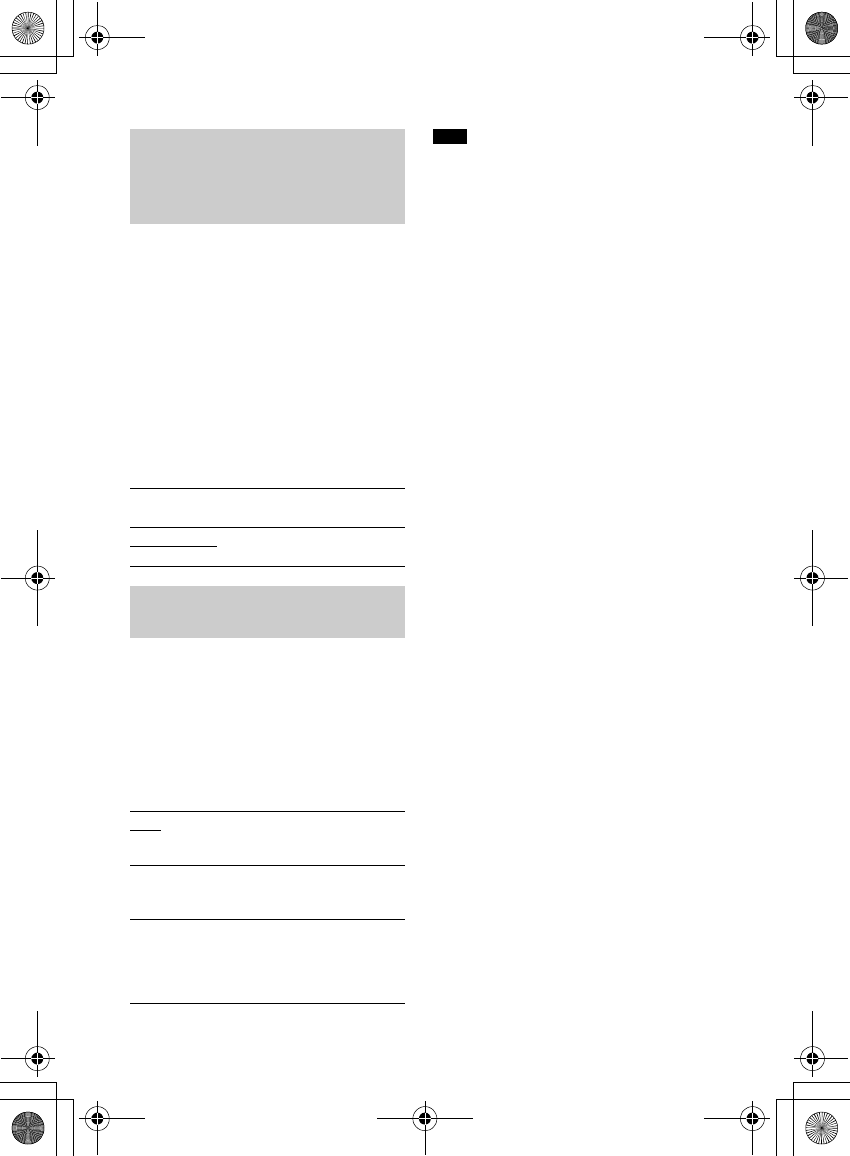
21US
K:\081\Win7 CS\new\4727410111_HT-S100F_US-CaFR-
LaES\01US\060SOU.fm
masterpage:
Right
HT-S100F
4-727-410-11(1)
This function works only when playing
the Dolby Digital signal of the device
that is connected to the TV IN
(OPTICAL)/HDMI OUT (TV (ARC)) jack.
When you set Dolby DRC (Dynamic
Range Control) to on, dynamic range of
the audio signal (range between the
maximum and minimum volume) is
compressed and sound with low
volume is easy to hear.
Press and hold AUDIO for 5 seconds to
set the function to on or off.
You can enjoy multiplex broadcast
sound when the system receives a
Dolby Digital multiplex broadcast signal.
Press AUDIO repeatedly.
The channel changes cyclically as
follows.
Main Sub Main/Sub
To receive a Dolby Digital signal, you need
to connect a TV or other devices to the TV
IN (OPTICAL) jack with the optical digital
cable (supplied) or the HDMI OUT (TV
(ARC)) jack with an HDMI cable (not
supplied).
Making Sound with Low
Volume Easy to Hear by
Compressing Dynamic
Range
Dolby DRC on
The USB indicator flashes twice.
Dolby DRC off
The USB indicator flashes once.
Enjoying Multiplex
Broadcast Sound (AUDIO)
Main
Outputs only the main channel.
The TV indicator flashes once.
Sub
Outputs only the sub channel.
The USB indicator flashes once.
Main/Sub
Main sound is output from the left speaker
and sub sound is output from the right
speaker.
The TV and USB indicators flash once.
Note
010COV.book Page 21 Thursday, September 7, 2017 11:33 AM
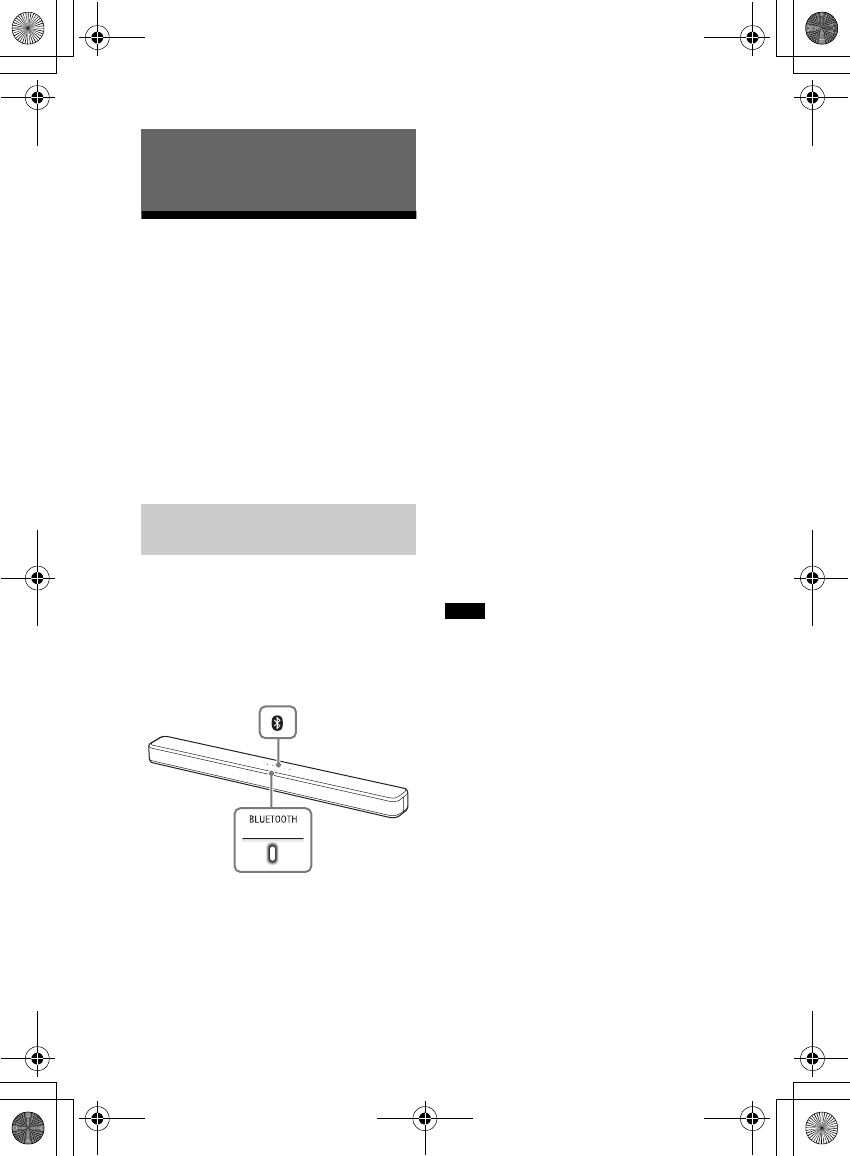
22US
HT-S100F
4-727-410-11(1)
K:\081\Win7 CS\new\4727410111_HT-S100F_US-CaFR-
LaES\01US\070BTF.fm
masterpage: Left
Listening to Music from
a Mobile Device
You can listen to music stored on a
mobile device such as a smartphone or
tablet via a wireless connection by
connecting the system and the mobile
device with the BLUETOOTH function.
When connecting to the mobile device
with the BLUETOOTH function, you can
operate by simply using the supplied
remote control without turning the TV
on.
1Press and hold the BLUETOOTH
button on the Bar Speaker for 5
seconds.
The system enters the pairing mode
and the BLUETOOTH indicator
flashes quickly.
2On the mobile device, turn on the
BLUETOOTH function, and then
select “HT-S100F” after searching
for it.
If a Passkey is requested, enter
“0000.”
3Make sure that the BLUETOOTH
indicator on the Bar Speaker lights
in blue.
A connection between the system
and mobile device has been
established.
4Start audio playback with the
music app on the connected
mobile device.
Sound is output from the Bar
Speaker.
5Adjust the volume.
• Adjust the volume by pressing
+/– on the remote control.
• and / on the remote
control can be used for the
BLUETOOTH function.
• You can pair up to 8 BLUETOOTH devices.
If a 9th BLUETOOTH device is paired, the
least recently connected device will be
replaced by the new one.
•Perform pairing for the second and
subsequent mobile devices.
Tips
•You can check the connection status of
the BLUETOOTH function by checking the
BLUETOOTH indicator status (page 9).
•While the BLUETOOTH input is being
selected, the system enters the pairing
mode by pressing the BLUETOOTH button
on the Bar Speaker shortly.
Listening to Music/Sound with the
BLUETOOTH® Function
Listening to Music by Pairing
with a Mobile Device
BLUETOOTH
indicator
BLUETOOTH
button
Notes
010COV.book Page 22 Thursday, September 7, 2017 11:33 AM
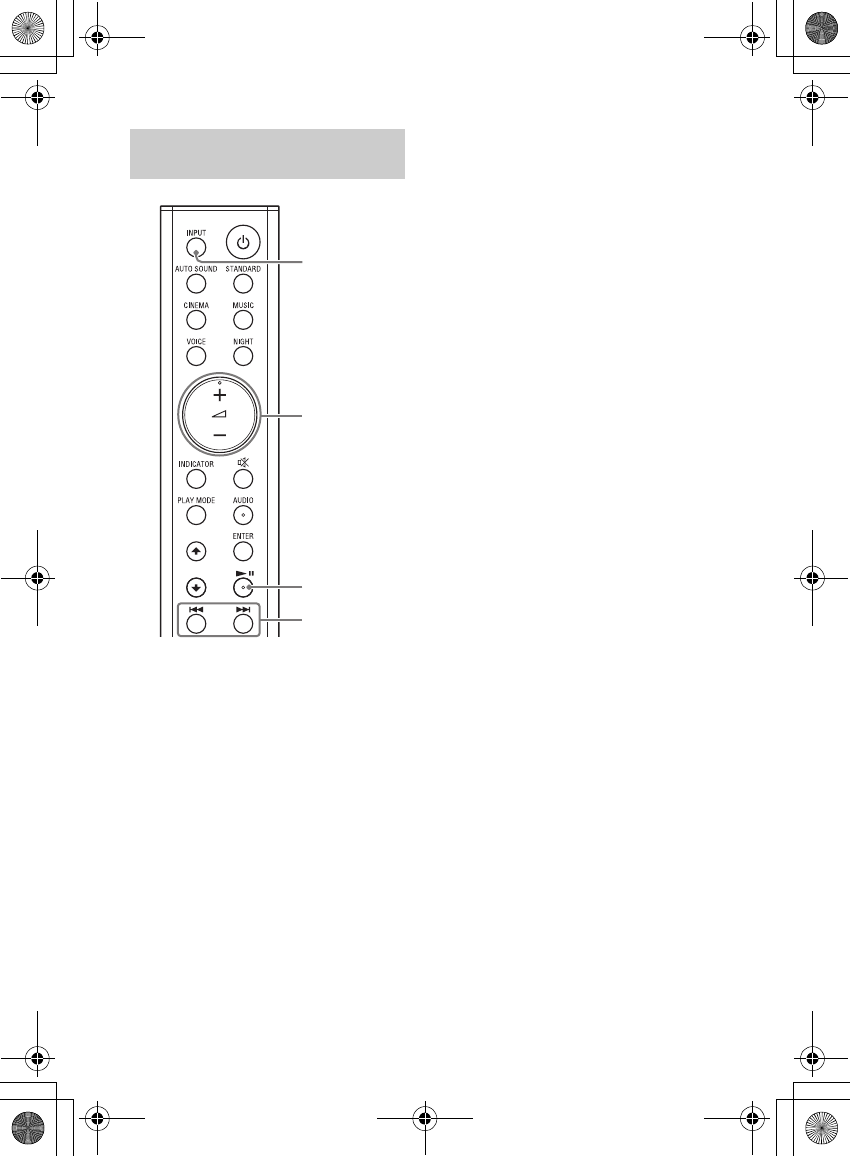
23US
K:\081\Win7 CS\new\4727410111_HT-S100F_US-CaFR-
LaES\01US\070BTF.fm
masterpage:
Right
HT-S100F
4-727-410-11(1)
1Turn the BLUETOOTH function of
the mobile device to on.
2Press INPUT repeatedly to select
the BLUETOOTH input or press the
BLUETOOTH button on the Bar
Speaker shortly.
The BLUETOOTH indicator flashes
and the system automatically
reconnects to the BLUETOOTH
device it was most recently
connected to.
3Make sure that the BLUETOOTH
indicator lights in blue.
A connection between the system
and mobile device has been
established.
4Start audio playback with the
music app on the connected
mobile device.
Sound is output from the Bar
Speaker.
5Adjust the volume.
• Adjust the volume by pressing
+/– on the remote control.
• and / on the remote
control can be used for the
BLUETOOTH function.
Listening to Music from the
Paired Mobile Device
INPUT
+/–
/
010COV.book Page 23 Thursday, September 7, 2017 11:33 AM
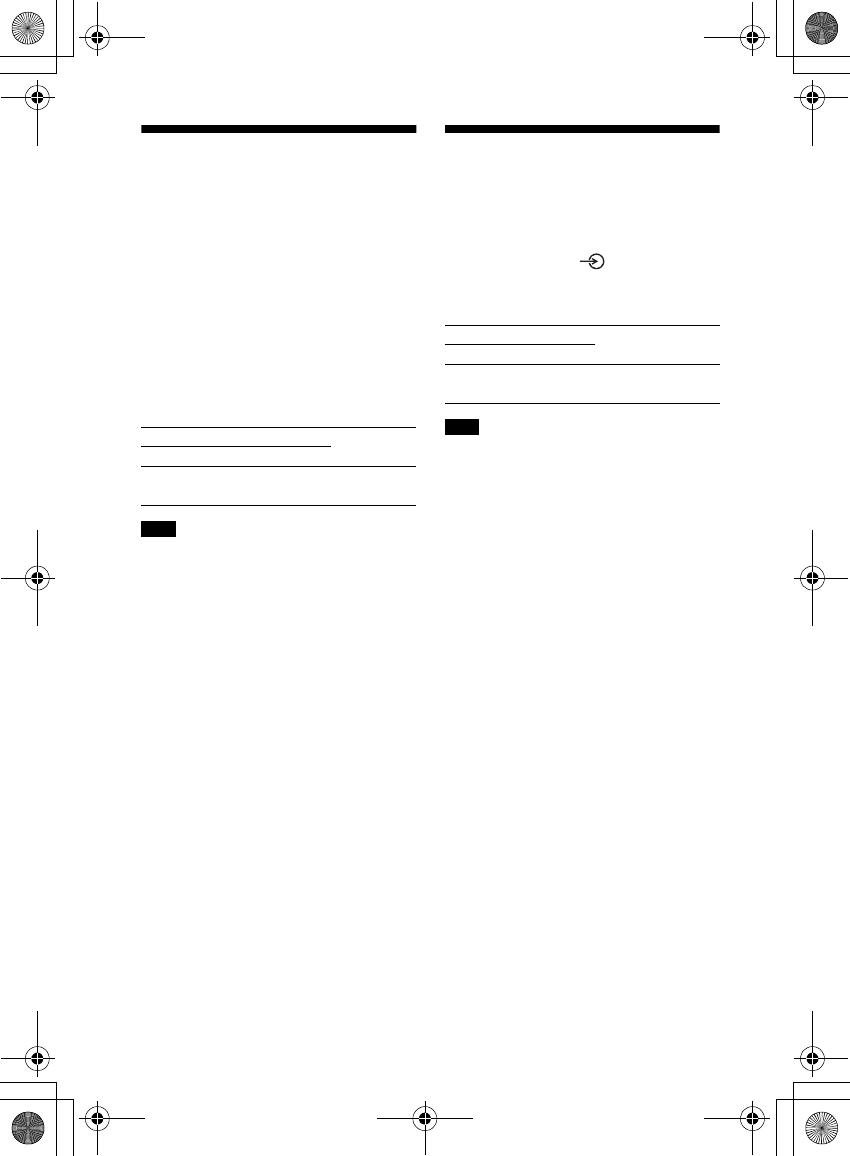
24US
HT-S100F
4-727-410-11(1)
K:\081\Win7 CS\new\4727410111_HT-S100F_US-CaFR-
LaES\01US\070BTF.fm
masterpage: Left
Turning the System On
by Operating the
BLUETOOTH Device
When the system has pairing
information, you can turn the system on
and listen to music from a BLUETOOTH
device even when the system is in
standby mode by setting the
BLUETOOTH standby mode to on.
Press and hold NIGHT for 5 seconds to
set the function to on or off.
While the BLUETOOTH standby mode is on,
standby power consumption increases.
Turning the BLUETOOTH
Function Off
You can turn the BLUETOOTH function off.
Press and hold , , and – on the
Bar Speaker for 10 seconds to set the
function to on or off.
When the BLUETOOTH function is set to off,
the BLUETOOTH input is skipped while
selecting input by pressing INPUT.
BLUETOOTH standby mode on
The USB indicator flashes twice.
BLUETOOTH standby mode off
The USB indicator flashes once.
Note
BLUETOOTH function on
The USB indicator flashes twice.
BLUETOOTH function off
The USB indicator flashes once.
Note
010COV.book Page 24 Thursday, September 7, 2017 11:33 AM

25US
K:\081\Win7 CS\new\4727410111_HT-S100F_US-CaFR-
LaES\01US\080OST.fm
masterpage:
Right
HT-S100F
4-727-410-11(1)
Using the Control for
HDMI Function
Connecting a device such as a TV or Blu-
ray Disc player compatible with the
Control for HDMI function* using an
HDMI cable (not supplied) enables you
to easily operate the device by using a
TV or Blu-ray Disc player remote control.
The following functions can be used
with the Control for HDMI function.
• System Power Off function
• System Audio Control function
•Audio Return Channel
• One-Touch Play function
These functions may work with devices
other than those manufactured by Sony,
but operation is not guaranteed.
* Control for HDMI is a standard used by
CEC (Consumer Electronics Control) for
allowing HDMI (High-Definition
Multimedia Interface) devices to control
each other.
Press and hold VOICE for 5 seconds to
set the function to on or off.
Enable the Control for HDMI function
settings for the TV and other device
connected to the TV.
When you turn off the TV, the system
will turn off automatically.
If you turn on the system while you are
watching the TV, the TV sound will be
output from the speakers of the system.
The volume of the system can be
adjusted using the TV remote control.
If the TV sound was output from the
speakers of the system the previous
time you watched the TV, the system
will be turned on automatically when
you turn on the TV again.
Operations can also be made by the
TV’s menu. For details, refer to the
operating instructions of your TV.
• Sound is only output from the TV if an
input other than the TV input is selected
when using the Twin Picture function on
the TV. When you disable the Twin Picture
function, the sound is output from the
system.
• The number for the system’s volume level
is displayed on the TV screen depending
on the TV.
• Depending on the settings of the TV, the
System Audio Control function may not
be available. For details, refer to the
operating instructions of your TV.
If the system is connected to a TV’s
HDMI IN jack compatible with Audio
Return Channel (ARC), you can listen to
TV sound from the speakers of the
system without connecting an optical
digital cable.
Using the Various Functions
Note
Preparing to Use the Control
for HDMI Function
Control for HDMI function on
The USB indicator flashes twice.
Control for HDMI function off
The USB indicator flashes once.
System Power Off Function
System Audio Control
Function
Notes
Audio Return Channel
010COV.book Page 25 Thursday, September 7, 2017 11:33 AM
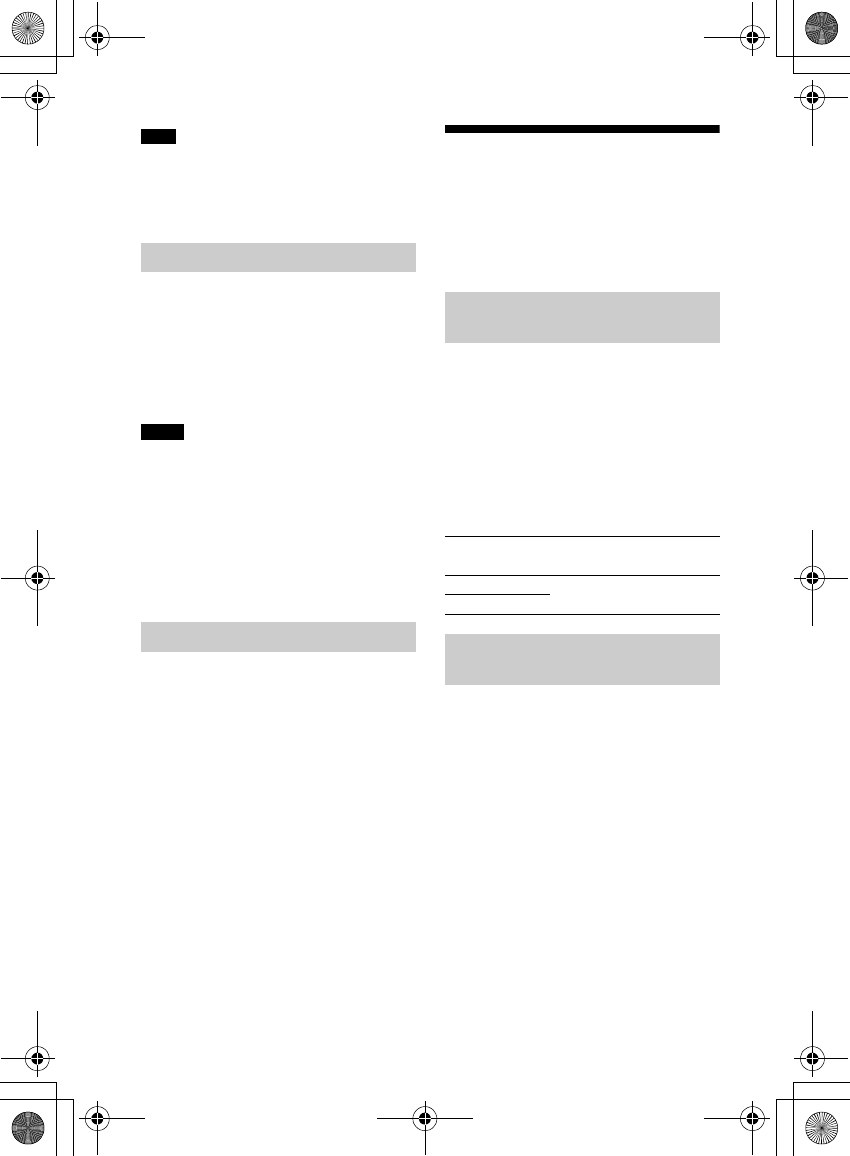
26US
HT-S100F
4-727-410-12(1)
K:\081\Win7 CS\new\4727410121_HT-S100F__US-FR-ES\01US\080OST.fm masterpage: Left
If the TV is not compatible with Audio
Return Channel, the optical digital cable
(supplied) needs to be connected (refer to
the supplied Startup Guide).
When you play content on a device (Blu-
ray Disc player, “PlayStation®4,” etc.)
connected to the TV, the system and TV
are turned on automatically, the input of
the system is switched to “TV” input,
and sound is output from the speakers
of the system.
•If the TV sound was output from the
speakers of the TV the previous time you
watched the TV, the system does not turn
on and the sound and picture are output
from the TV even if device content is
played.
•Depending on the TV, the beginning part
of content being played may not play
correctly.
• Use an HDMI-authorized cable.
• Use a Sony High Speed HDMI Cable
with the Cable Type Logo.
• We do not recommend using an
HDMI-DVI conversion cable.
• Audio signals (sampling frequency, bit
length, etc.) transmitted from an HDMI
jack may be suppressed by the
connected device.
Saving Power
Consumption
To use the system while saving power
consumption, change the following
settings.
When you set the auto standby function
to on, the system enters standby mode
automatically when you do not operate
the system for about 20 minutes and
the system is not receiving an input
signal.
Press and hold CINEMA for 5 seconds
to set the function to on or off.
To save power consumption during the
standby mode, set the BLUETOOTH
standby mode (page 24) and Control for
HDMI function (page 25) to off.
The default settings for them are on.
Note
One-Touch Play Function
Notes
Notes on HDMI Connections
Turn the System Off by
Detecting the Using State
Auto standby on
The USB indicator flashes twice.
Auto standby off
The USB indicator flashes once.
Saving Power in Standby
Mode
080OST.fm Page 26 Friday, October 13, 2017 9:13 AM
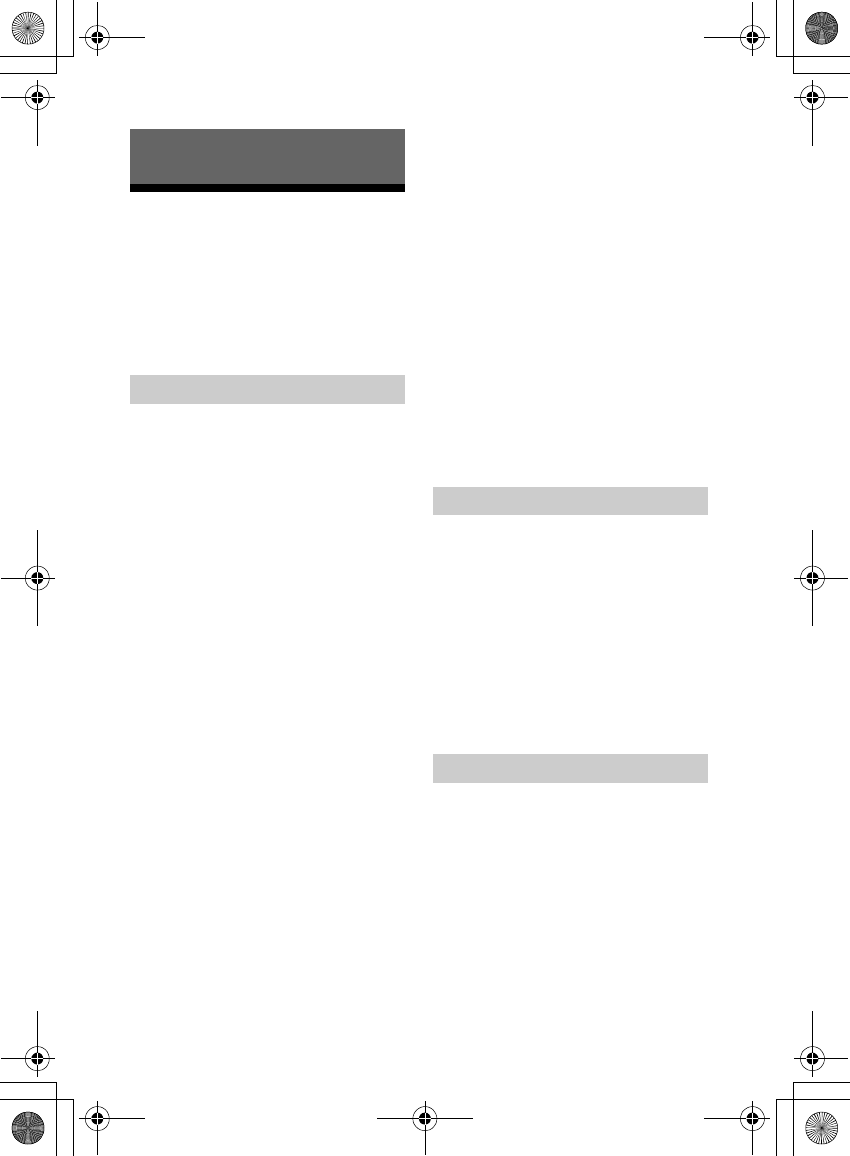
27US
K:\081\Win7 CS\new2\4727410121_HT-S100F__US-FR-
ES\01US\090TBS.fm
masterpage:
Right
HT-S100F
4-727-410-12(1)
Troubleshooting
If you experience any of the following
difficulties while using the system, use
this troubleshooting guide to help
remedy the problem before requesting
repairs. Should any problem persist,
consult your nearest Sony dealer.
The system does not power up.
Check that the AC power cord (mains
lead) is connected securely.
Disconnect the AC power cord (mains
lead) from the wall outlet (mains),
and then reconnect after several
minutes.
The system is turned off
automatically.
The auto standby function is working.
Set the auto standby function to off
(page 26).
The system does not turn on even
when the TV is turned on.
Set the Control for HDMI function to
on (page 25). The TV must support
the Control for HDMI function. For
details, refer to the operating
instructions of your TV.
Check the speaker settings of the TV.
The system power syncs with the
speaker settings of the TV. For details,
refer to the operating instructions of
your TV.
If the sound was output from the
speakers of the TV the previous time,
the system does not turn on even
when the TV is turned on.
The system turns off when the TV is
turned off.
Check the setting of the Control for
HDMI function (page 25). When the
Control for HDMI function is set to on,
the system turns off automatically
when you turn off the TV regardless
of the input.
The system does not turn off even
when the TV is turned off.
Check the setting of the Control for
HDMI function (page 25). To turn the
system off automatically regardless
of the input when you turn off the TV,
set the Control for HDMI function to
on. The TV must support the Control
for HDMI function. For details, refer to
the operating instructions of your TV.
There is no picture or the picture is
not output correctly.
Select the appropriate input
(page 17).
When there is no picture while TV
input is selected, select the TV
channel that you want using the TV
remote control.
Disconnect the HDMI cable, then
connect it again. Make sure that the
cable is firmly inserted.
No TV sound is output from the
system.
Check the type and connection of the
HDMI cable or optical digital cable
that is connected to the system and
the TV (refer to the supplied Startup
Guide).
Disconnect the cables that are
connected between the TV and the
system, then connect them firmly
again. Disconnect the AC power cords
Troubleshooting
Power
Picture
Sound
090TBS.fm Page 27 Tuesday, October 10, 2017 11:25 AM
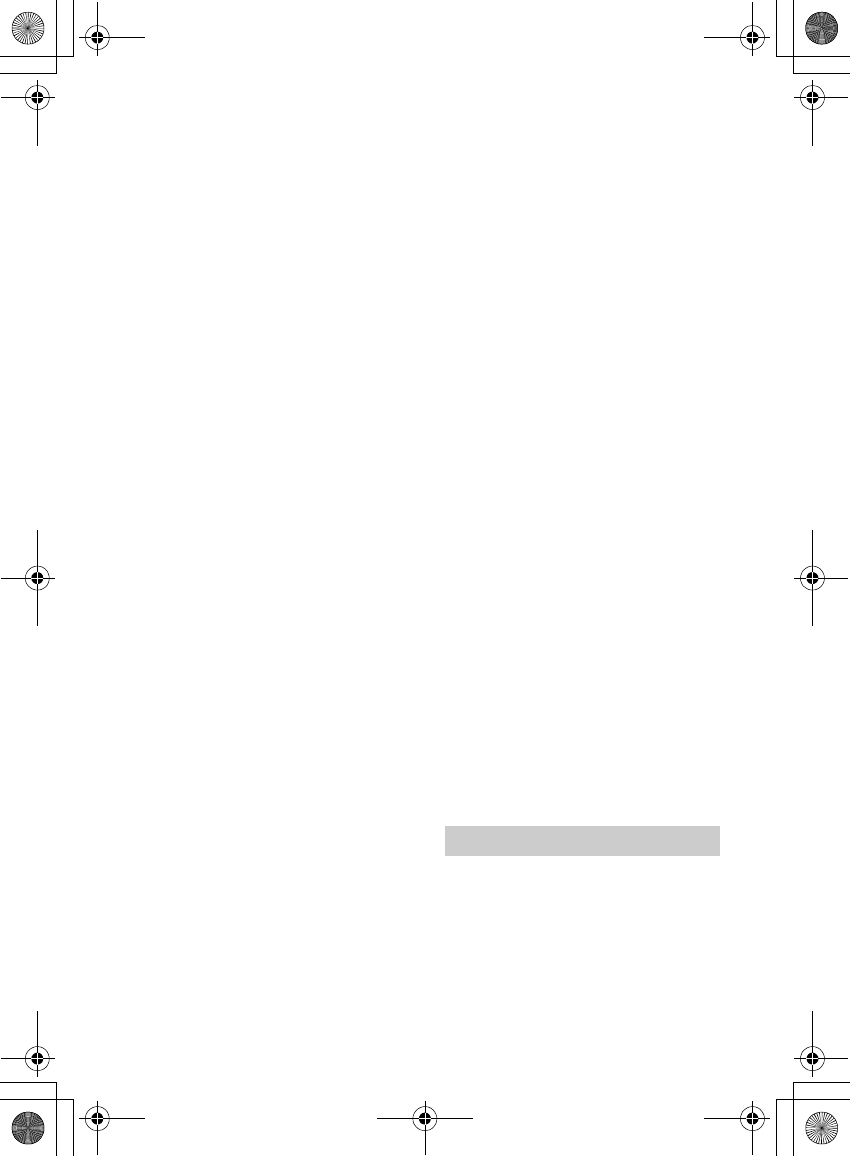
28US
HT-S100F
4-727-410-12(1)
K:\081\Win7 CS\new2\4727410121_HT-S100F__US-FR-
ES\01US\090TBS.fm
masterpage: Left
of the TV and the system from the AC
outlets (mains), then connect them
again.
When the system and TV are
connected with an HDMI cable, check
the following.
– The HDMI jack of the connected TV
is labeled with “ARC.”
– The Control for HDMI function of the
TV is set to on.
– On the system, the Control for HDMI
function is set to on (page 25).
If your TV is not compatible with
Audio Return Channel, connect the
optical digital cable (supplied) (refer
to the supplied Startup Guide). If the
TV is not compatible with Audio
Return Channel, TV sound will not be
output from the system even if the
system is connected to the TV’s HDMI
IN jack.
If the sound of the device that is
connected to the optical input jack of
the TV is not output, try the following.
– Connect the cable box or satellite
box directly to the TV IN (OPTICAL)
jack of the system.
Press INPUT repeatedly to select the
TV input (page 17).
Increase the volume on the TV or
cancel muting.
Depending on the order in which you
connect the TV and the system, the
system may be muted. If this
happens, turn on the TV first, then the
system.
Set the speakers setting of the TV
(BRAVIA) to Audio System. Refer to
the operating instructions of your TV
regarding how to set the TV.
Check the sound output of the TV.
Refer to the operating instructions of
the TV for the TV settings.
The system supports the Dolby Digital
and PCM audio formats (page 34).
When you playback unsupported
format, set the digital audio out
setting of the TV (BRAVIA) to “PCM.”
For details, refer to the operating
instructions of your TV.
The sound is output from both the
system and the TV.
Mute the sound of the system or the
TV.
No sound or only a very low-level
sound of the device connected to
the system is heard from the
system.
Press + and check the volume
level (page 12).
Press or + to cancel the muting
function (page 12).
Make sure the input source is
selected correctly. You should try
other input sources by pressing
INPUT repeatedly (page 17).
Check that all the cables and cords of
the system and the connected device
are firmly inserted.
If the connected device supports the
up-sampling feature, you need to
turn it off.
The surround effect cannot be
obtained.
Depending on the input signal and
the sound mode setting, surround
sound processing may not work
effectively. The surround effect may
be subtle, depending on the program
or disc.
To play multi channel audio, check
the digital audio output setting on
the device connected to the system.
For details, refer to the operating
instructions supplied with the
connected device.
The USB device is not recognized.
Try the following:
Turn the system off.
Remove and reconnect the USB
device.
Turn the system on.
USB Device Connection
090TBS.fm Page 28 Tuesday, October 10, 2017 11:25 AM

29US
K:\081\Win7 CS\new\4727410111_HT-S100F_US-CaFR-
LaES\01US\090TBS.fm
masterpage:
Right
HT-S100F
4-727-410-11(1)
Make sure that the USB device is
securely connected to the (USB)
port (page 18).
Check to see if the USB device or a
cable is damaged.
Make sure that the USB device is on.
If the USB device is connected via a
USB hub, disconnect it and connect
the USB device directly to the system.
BLUETOOTH connection cannot be
completed.
Make sure that the BLUETOOTH
indicator on the Bar Speaker is lit
(page 8).
Make sure the BLUETOOTH device to
be connected is turned on and the
BLUETOOTH function is enabled.
Bring the BLUETOOTH device close to
the system.
Pair this system and the BLUETOOTH
device again. You may need to cancel
the pairing with this system using
your BLUETOOTH device first.
If the BLUETOOTH function is set to
off, set it to on (page 24).
Pairing cannot be achieved.
Bring the BLUETOOTH device close to
the system.
Make sure this system is not receiving
interference from a wireless LAN
device, other 2.4 GHz wireless
devices, or a microwave oven. If a
device that generates
electromagnetic radiation is nearby,
move the device away from this
system.
Pairing may not be possible if other
BLUETOOTH devices are present
around the system. In this case, turn
off the other BLUETOOTH devices.
Sound of the connected
BLUETOOTH mobile device is not
output from the system.
Make sure that the BLUETOOTH
indicator on the Bar Speaker is lit
(page 8).
Bring the BLUETOOTH device close to
the system.
If a device that generates
electromagnetic radiation, such as a
wireless LAN device, other
BLUETOOTH devices, or a microwave
oven is nearby, move the device away
from this system.
Move the USB 3.0 device and its cable
away from this system.
Remove any obstacle between this
system and the BLUETOOTH device or
move this system away from the
obstacle.
Reposition the connected
BLUETOOTH device.
Switch the wireless LAN frequency of
any nearby wireless LAN router or PC
to 5 GHz range.
Increase the volume on the
connected BLUETOOTH device.
The sound is not in sync with the
image.
When you are watching movies, you
may hear the sound with a slight
delay from the image.
The remote control of this system
does not function.
Point the remote control at the
remote control sensor on the Bar
Speaker (page 8).
Remove any obstacles in the path
between the remote control and the
system.
Replace both batteries in the remote
control with new ones, if they are
weak.
Mobile Device Connection
Remote Control
010COV.book Page 29 Thursday, September 7, 2017 11:33 AM

30US
HT-S100F
4-727-410-11(1)
K:\081\Win7 CS\new\4727410111_HT-S100F_US-CaFR-
LaES\01US\090TBS.fm
masterpage: Left
Make sure you are pressing the
correct button on the remote control
(page 12).
The TV remote control does not
work.
Install the Bar Speaker so that it does
not obstruct the remote control
sensor of the TV.
This problem might be solved by
enabling the IR repeater function
(page 16).
The Control for HDMI function does
not work properly.
Check the connection with the
system (refer to the supplied Startup
Guide).
Enable the Control for HDMI function
on the TV. For details, refer to the
operating instructions of your TV.
Wait a while, and then try again. If
you unplug the system, it will take a
while before operations can be made.
Wait for 15 seconds or longer, and
then try again.
Make sure the devices connected to
the system support the Control for
HDMI function.
Enable the Control for HDMI function
of the devices connected to the
system. For details, refer to the
operating instructions of your device.
The type and number of devices that
can be controlled by the Control for
HDMI function is restricted by the
HDMI CEC standard as follows:
– Recording devices (Blu-ray Disc
recorder, DVD recorder, etc.): up to
3 devices
– Playback devices (Blu-ray Disc
player, DVD player, etc.): up to 3
devices
– Tuner-related devices: up to 4
devices
– Audio system (receiver/
headphone): up to 1 device (used by
this system)
All indicators on the Bar Speaker
flash, the sound is muted, and
buttons on the remote control or
Bar Speaker other than (power)
do not work.
The protection feature is activated.
Press (power) to turn the system
off and disconnect the AC power cord
(mains lead) and check the items
below.
– Make sure that the ventilations of
the Bar Speaker are not covered and
turn on the system after a while.
– When the system is using the USB
connection, remove the USB device
and turn on the system. If the
system operates properly, the
current of the connected USB device
is over the maximum output current
of the system 500 mA, or the USB
device may have an abnormality.
Sensors of the TV do not work
properly.
The Bar Speaker may block some
sensors (such as the brightness
sensor), the remote control receiver
of your TV or the emitter for 3D
glasses (infrared transmission) of a 3D
TV that supports the infrared 3D glass
system, or wireless communication.
Move the Bar Speaker away from the
TV within a range that allows those
parts to operate properly. For the
locations of the sensors and remote
control receiver, refer to the
operating instructions supplied with
the TV.
Others
010COV.book Page 30 Thursday, September 7, 2017 11:33 AM
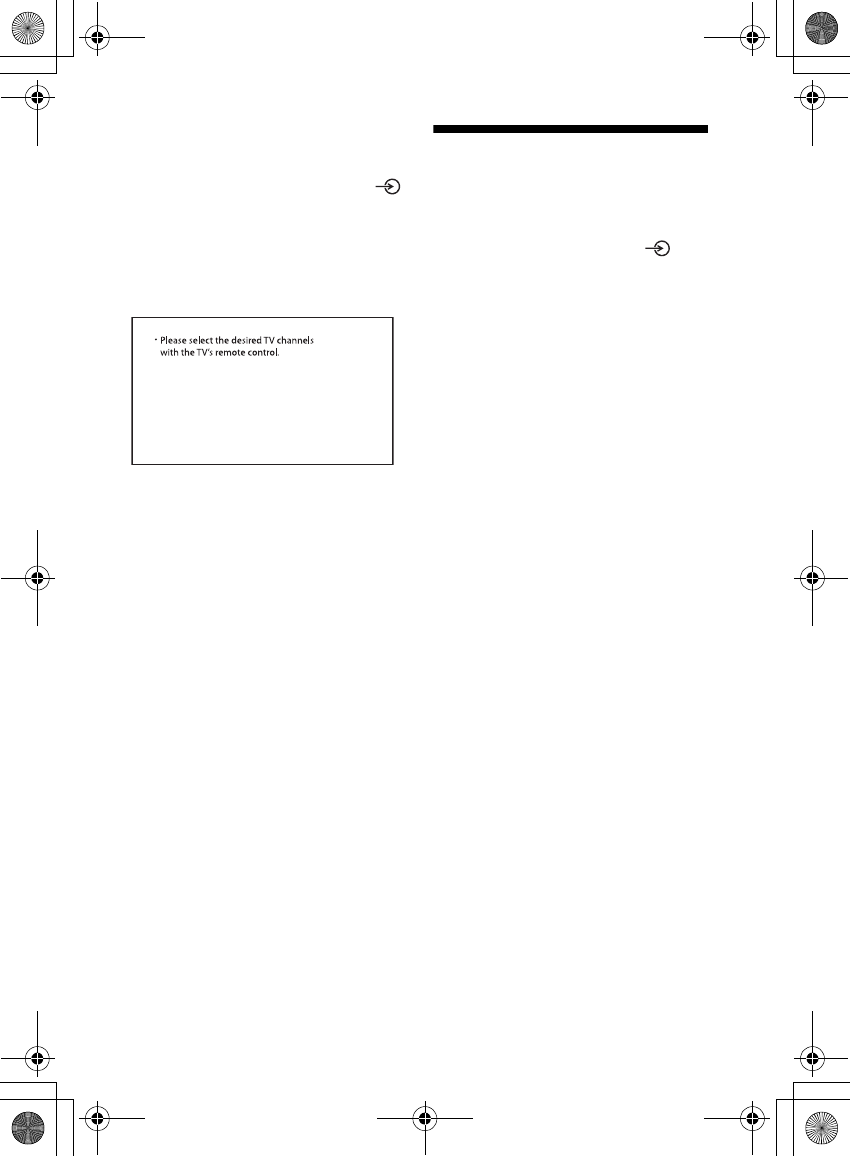
31US
K:\081\Win7 CS\new\4727410111_HT-S100F_US-CaFR-
LaES\01US\090TBS.fm
masterpage:
Right
HT-S100F
4-727-410-11(1)
The system does not work properly.
The system may be in demo mode. To
cancel demo mode, reset the system.
Press and hold (power), +, and
on the Bar Speaker for more than 5
seconds (page 31).
When you change to the TV input
from the USB input by pressing
INPUT, the message appears.
* This screen is an example for English.
Select the TV program by using the TV
remote control.
Resetting the System
If the system still does not operate
properly, reset the system as follows.
1Press and hold , +, and on
the Bar Speaker for more than 5
seconds.
All indicators on the Bar Speaker
flash 3 times, and the settings
return to their initial status.
2Disconnect the AC power cord
(mains lead).
3Connect the AC power cord (mains
lead), then press to turn on the
system.
Tip
The default settings are underlined on
each feature description.
010COV.book Page 31 Thursday, September 7, 2017 11:33 AM
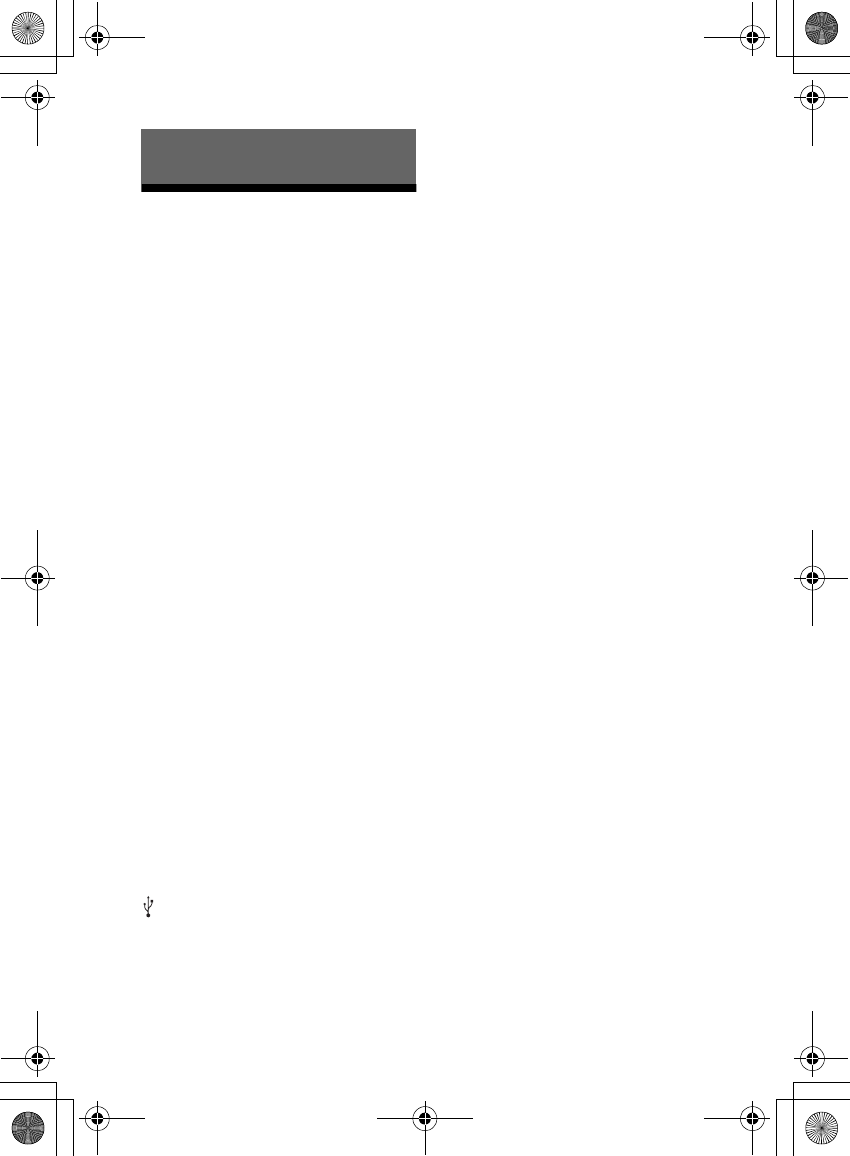
32US
HT-S100F
4-727-410-12(1)
K:\081\Win7 CS\new2\4727410121_HT-S100F__US-FR-
ES\01US\100OTH.fm
masterpage: Left
Specifications
Amplifier section
U.S. models:
POWER OUTPUT AND TOTAL HARMONIC
DISTORTION:
(FTC)
Front L + Front R:
With 8 ohms loads, both channels
driven, from 100 - 5,000 Hz; rated
20 W per channel minimum RMS
power, with no more than 1% total
harmonic distortion from 250 mW to
rated output.
POWER OUTPUT (reference)
Front L/R woofer blocks: 30 W (per
channel at 8 ohms, 1 kHz)
Front L/R tweeter blocks: 30 W (per
channel at 8 ohms, 10 kHz)
Canadian models:
POWER OUTPUT (rated)
Front woofer L + Front woofer R: 22 W
+ 22 W (at 8 ohms, 1 kHz, 1% THD)
Front tweeter L + Front tweeter R: 22 W
+ 22 W (at 8 ohms, 10 kHz, 1% THD)
POWER OUTPUT (reference)
Front L/R woofer blocks: 30 W (per
channel at 8 ohms, 1 kHz)
Front L/R tweeter blocks: 30 W (per
channel at 8 ohms, 10 kHz)
Audio Inputs
TV IN (OPTICAL)
USB
HDMI OUT (TV (ARC))
TV Display Output (USB display)
HDMI OUT (TV (ARC))
USB section
(USB) port:
Type A (For connecting USB memory)
BLUETOOTH section
Communication system
BLUETOOTH Specification version 4.2
Output
BLUETOOTH Specification Power
Class 1
Maximum communication range
Line of sight approx. 10 m1)
Frequency band
2.4 GHz band (2.4000 GHz -
2.4835 GHz)
Modulation method
FHSS (Freq Hopping Spread Spectrum)
Compatible BLUETOOTH profiles2)
A2DP (Advanced Audio Distribution
Profile)
AVRCP (Audio Video Remote Control
Profile)
Supported Codec3)
SBC4)
Transmission range (A2DP)
20 Hz - 20,000 Hz (Sampling frequency
32 kHz, 44.1 kHz, 48 kHz)
1) The actual range will vary depending on
factors such as obstacles between
devices, magnetic fields around a
microwave oven, static electricity,
cordless phone use, reception
sensitivity, the operating system,
software applications, etc.
2) BLUETOOTH standard profiles indicate
the purpose of BLUETOOTH
communication between devices.
3) Codec: Audio signal compression and
conversion format
4) Abbreviation for Subband Codec
Front L/Front R speaker block section
Speaker system
2-way speaker system, Bass reflex
Speaker
Woofer: 48 mm × 90 mm
(1 7/9 in × 3 5/9 in) cone type
Tweeter: 25 mm (1 in) balanced dome
type
General
Power requirements
120 V AC, 60 Hz
Power consumption
On: 30 W
Standby mode: 0.5 W or less (Power
Saving mode)
(When Control for HDMI function and
Additional Information
100OTH.fm Page 32 Tuesday, October 10, 2017 11:25 AM

33US
K:\081\Win7 CS\new\4727410121_HT-S100F__US-FR-ES\01US\100OTH.fm masterpage:
Right
HT-S100F
4-727-410-12(1)
BLUETOOTH Standby mode are set to
off)
Standby mode: 2 W or less
(When Control for HDMI function is set
to on and/or BLUETOOTH Standby
mode is set to on)
Dimensions* (approx.) (w/h/d)
900 mm × 64 mm × 90 mm (35 1/2 in ×
2 5/8 in × 3 5/8 in)
* Including projection portion
Mass (approx.)
2.4 kg (5 lb 4 7/10 oz)
Design and specifications are subject to
change without notice.
100OTH.fm Page 33 Friday, October 13, 2017 9:14 AM
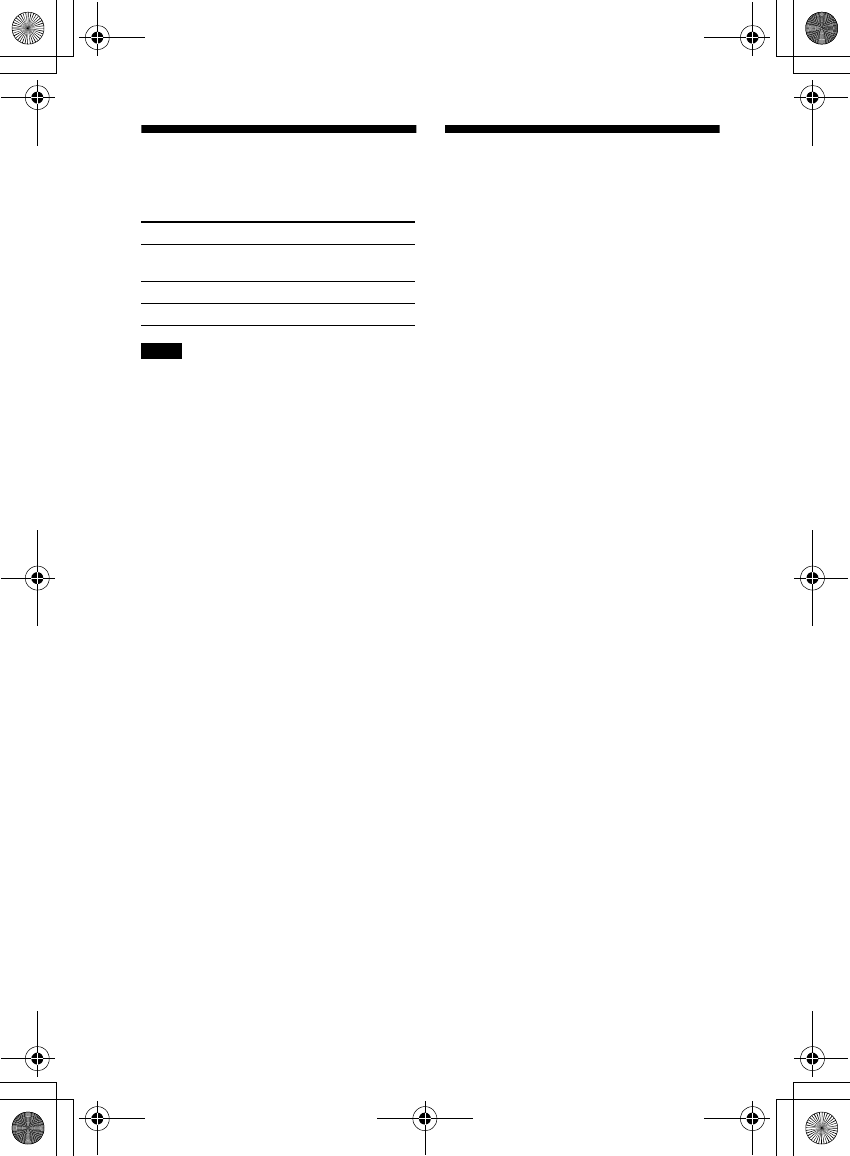
34US
HT-S100F
4-727-410-11(1)
K:\081\Win7 CS\new\4727410111_HT-S100F_US-CaFR-
LaES\01US\100OTH.fm
masterpage: Left
Playable Types of Files
(USB Input)
•Some files may not play or may play with
no sound depending on the file format,
the file encoding, or the recording
condition.
•Some files edited on a PC may not play.
•The system does not play coded files such
as DRM and Lossless.
•The system can recognize the following
files or folders in USB devices:
– up to 200 folders (including empty
folder and root folder)
– up to 150 tracks in one folder
– up to folders in the 8th layer (including
the root folder)
•Some USB devices may not work with this
system.
•The system can recognize Mass Storage
Class (MSC) devices.
Supported Input Audio
Formats (HDMI OUT (TV
(ARC)) or TV IN (OPTICAL))
Audio formats supported by this system
are as follows.
•Dolby Digital
•Linear PCM 2ch
Codec Extension
MP3 (MPEG-1 Audio
Layer III)
.mp3
WMA9 Standard .wma
LPCM (2ch) .wav
Notes
010COV.book Page 34 Thursday, September 7, 2017 11:33 AM

35US
K:\081\Win7 CS\new\4727410111_HT-S100F_US-CaFR-
LaES\01US\100OTH.fm
masterpage:
Right
HT-S100F
4-727-410-11(1)
On BLUETOOTH
Communication
• BLUETOOTH devices should be used
within approximately 10 meters
(33 feet) (unobstructed distance) of
each other. The effective
communication range may become
shorter under the following
conditions.
– When a person, metal object, wall or
other obstruction is between the
devices with a BLUETOOTH
connection
– Locations where a wireless LAN is
installed
– Around microwave ovens that are in
use
– Locations where other
electromagnetic waves occur
• BLUETOOTH devices and wireless LAN
(IEEE 802.11b/g/n) use the same
frequency band (2.4 GHz). When using
your BLUETOOTH device near a device
with wireless LAN capability,
electromagnetic interference may
occur. This could result in lower data
transfer rates, noise, or inability to
connect. If this happens, try the
following remedies:
– Use this system at least 10 meters
(33 feet) away from the wireless LAN
device.
– Turn off the power to the wireless
LAN device when using your
BLUETOOTH device within 10 meters
(33 feet).
– Install this system and BLUETOOTH
device as closer to each other as
possible.
• The radio waves broadcast by this
system may interfere with the
operation of some medical devices.
Since this interference may result in
malfunction, always turn off the power
on this system and BLUETOOTH device
in the following locations:
– In hospitals, on trains, in airplanes, at
gas stations, and any place where
flammable gasses may be present
– Near automatic doors or fire alarms
• This system supports security
functions that comply with the
BLUETOOTH specification to ensure
secure connection during
communication using BLUETOOTH
technology. However, this security
may be insufficient depending on the
setting contents and other factors, so
always be careful when performing
communication using BLUETOOTH
technology.
• Sony cannot be held liable in any way
for damages or other loss resulting
from information leaks during
communication using BLUETOOTH
technology.
• BLUETOOTH communication is not
necessarily guaranteed with all
BLUETOOTH devices that have the
same profile as this system.
• BLUETOOTH devices connected with
this system must comply with the
BLUETOOTH specification prescribed
by the Bluetooth SIG, Inc., and must be
certified to comply. However, even
when a device complies with the
BLUETOOTH specification, there may
be cases where the characteristics or
specifications of the BLUETOOTH
device make it impossible to connect,
or may result in different control
methods, display or operation.
• Noise may occur or the audio may cut
off depending on the BLUETOOTH
device connected with this system,
the communications environment, or
surrounding conditions.
If you have any questions or problems
concerning your system, please consult
your nearest Sony dealer.
010COV.book Page 35 Thursday, September 7, 2017 11:33 AM

36US
HT-S100F
4-727-410-11(1)
K:\081\Win7 CS\new\4727410111_HT-S100F_US-CaFR-
LaES\01US\100OTH.fm
masterpage: Left
Precautions
On safety
• Should any solid object or liquid fall into
the system, unplug the system and have
it checked by qualified personnel before
operating it any further.
•Do not climb on the Bar Speaker, as you
may fall down and injure yourself, or
system damage may result.
On power sources
•Before operating the system, check that
the operating voltage is identical to your
local power supply. The operating voltage
is indicated on the nameplate on the
bottom of the Bar Speaker.
•If you are not going to use the system for
a long time, be sure to disconnect the
system from the wall outlet (mains). To
disconnect the AC power cord (mains
lead), grasp the plug itself; never pull the
cord.
•One blade of the plug is wider than the
other for the purpose of safety and will fit
into the wall outlet (mains) only one way.
If you are unable to insert the plug fully
into the outlet, contact your dealer.
• AC power cord (mains lead) must be
changed only at a qualified service shop.
On heat buildup
Although the system heats up during
operation, this is not a malfunction.
If you continuously use this system at high
volume, the system temperature at the
rear and bottom rises considerably. To
avoid burning yourself, do not touch the
system.
On placement
• Place the system in a location with
adequate ventilation to prevent heat
buildup and prolong the life of the
system.
•Do not place the system near heat
sources or in a place subject to direct
sunlight, excessive dust, or mechanical
shock.
•Do not place anything on the top of the
Bar Speaker.
•If the system is being used in combination
with a TV, VCR, or tape deck, noise may
result and picture quality may suffer. In
such a case, place the system away from
the TV, VCR, or tape deck.
•Use caution when placing the system on a
surface that has been specially treated
(with wax, oil, polish, etc.), as staining or
discoloration of the surface may result.
• Take care to avoid any possible injury
from the corners of the Bar Speaker.
On operation
Before connecting other equipment, be
sure to turn off and unplug the system.
If you encounter color irregularity
on a nearby TV screen
Color irregularities may be observed on
certain types of TV.
•If color irregularity is observed...
Turn off the TV, then turn it on again after
15 to 30 minutes.
•If color irregularity is observed again...
Place the system further away from the
TV.
On cleaning
Clean the system with a soft, dry cloth. Do
not use any type of abrasive pad, scouring
powder, or solvent such as alcohol or
benzine.
If you have any question or problem
concerning your system, please consult
your nearest Sony dealer.
010COV.book Page 36 Thursday, September 7, 2017 11:33 AM

37US
K:\081\Win7 CS\new\4727410111_HT-S100F_US-CaFR-
LaES\01US\100OTH.fm
masterpage:
Right
HT-S100F
4-727-410-11(1)
This system incorporates Dolby* Digital.
* Manufactured under license from Dolby
Laboratories.
Dolby, Dolby Audio and the double-D
symbol are trademarks of Dolby
Laboratories.
This system incorporates High-Definition
Multimedia Interface (HDMI™) technology.
The terms HDMI and HDMI High-Definition
Multimedia Interface, and the HDMI Logo
are trademarks or registered trademarks of
HDMI Licensing Administrator, Inc. in the
United States and other countries.
The BLUETOOTH® word mark and logos are
registered trademarks owned by Bluetooth
SIG, Inc. and any use of such marks by Sony
Corporation is under license. Other
trademarks and trade names are those of
their respective owners.
“BRAVIA” logo is a trademark of Sony
Corporation.
MPEG Layer-3 audio coding technology
and patents licensed from Fraunhofer IIS
and Thomson.
Windows Media is either a registered
trademark or trademark of Microsoft
Corporation in the United States and/or
other countries.
This product is protected by certain
intellectual property rights of Microsoft
Corporation. Use or distribution of such
technology outside of this product is
prohibited without a license from Microsoft
or an authorized Microsoft subsidiary.
All other trademarks are trademarks of
their respective owners.
Copyrights and Trademarks
010COV.book Page 37 Thursday, September 7, 2017 11:33 AM

2FR
K:\081\Win7 CS\new\4727410111_HT-S100F_US-CaFR-
LaES\02FR\020REG.fm
masterpage: Left
HT-S100F
4-727-410-11(1)
Enregistrement du propriétaire
Les numéros de modèle et de série sont
situés sur la partie inférieure de la barre
de haut-parleurs. Notez les numéros
dans l’espace ci-dessous. Reportez-
vous à ces numéros lorsque vous
contactez votre détaillant Sony à propos
de cet appareil.
N° de modèle HT-S100F
N° de série
Pour réduire les risques d’incendie ou
d’électrocution, gardez cet appareil à
l’abri de la pluie et de l’humidité.
L’appareil n’est pas débranché du
secteur aussi longtemps qu’il est
raccordé à la prise secteur, même s’il
s’éteint automatiquement.
Pour réduire le risque d’incendie,
n’obstruez pas l’orifice de ventilation de
l’appareil avec un journal, une nappe,
une tenture, etc.
N’exposez pas l’appareil à une source
de flamme nue (par exemple, une
bougie allumée).
Pour réduire le risque d’incendie ou
d’électrocution, n’exposez pas cet
appareil à des éclaboussures ou des
gouttes d’eau et ne posez pas dessus
des objets remplis de liquides,
notamment des vases.
La fiche principale étant utilisée pour
déconnecter l’unité de l’alimentation
secteur, connectez l’unité à une prise
secteur aisément accessible. Si vous
remarquez une anomalie dans
l’appareil, débranchez immédiatement
la fiche principale de la prise secteur.
N’installez pas l’appareil dans un
espace confiné, tel qu’une bibliothèque
ou un meuble encastré.
MISE EN GARDE
Risque d’explosion si la pile est
remplacée par un type de pile
inadéquat.
N’exposez pas les piles ou un appareil
contenant des piles à une chaleur
excessive, notamment aux rayons
directs du soleil ou à des flammes.
Utilisation à l’intérieur seulement.
Pour la barre de haut-parleurs
La plaque signalétique et la date de
fabrication sont situées sur la partie
inférieure de la barre de haut-parleurs.
Pour les clients aux États-Unis
L’inscription de mise en garde est
apposée sur l’enceinte inférieure (Pour
la barre de haut-parleurs).
Ce symbole est destiné à
renseigner l’utilisateur sur la
présence à l’intérieur du boîtier
de l’appareil d’une « tension
dangereuse » non isolée et
suffisamment puissante pour présenter
un risque d’électrocution.
Ce symbole est destiné à
renseigner l’utilisateur sur la
présence d’importantes
instructions d’utilisation et
d’entretien (service) dans les
documents qui accompagnent
l’appareil.
Consignes de sécurité importantes
1) Lisez ces instructions.
2) Conservez ces instructions.
3) Respectez tous les avertissements.
AVERTISSEMENT
020REG.fm Page 2 Monday, September 11, 2017 4:25 PM
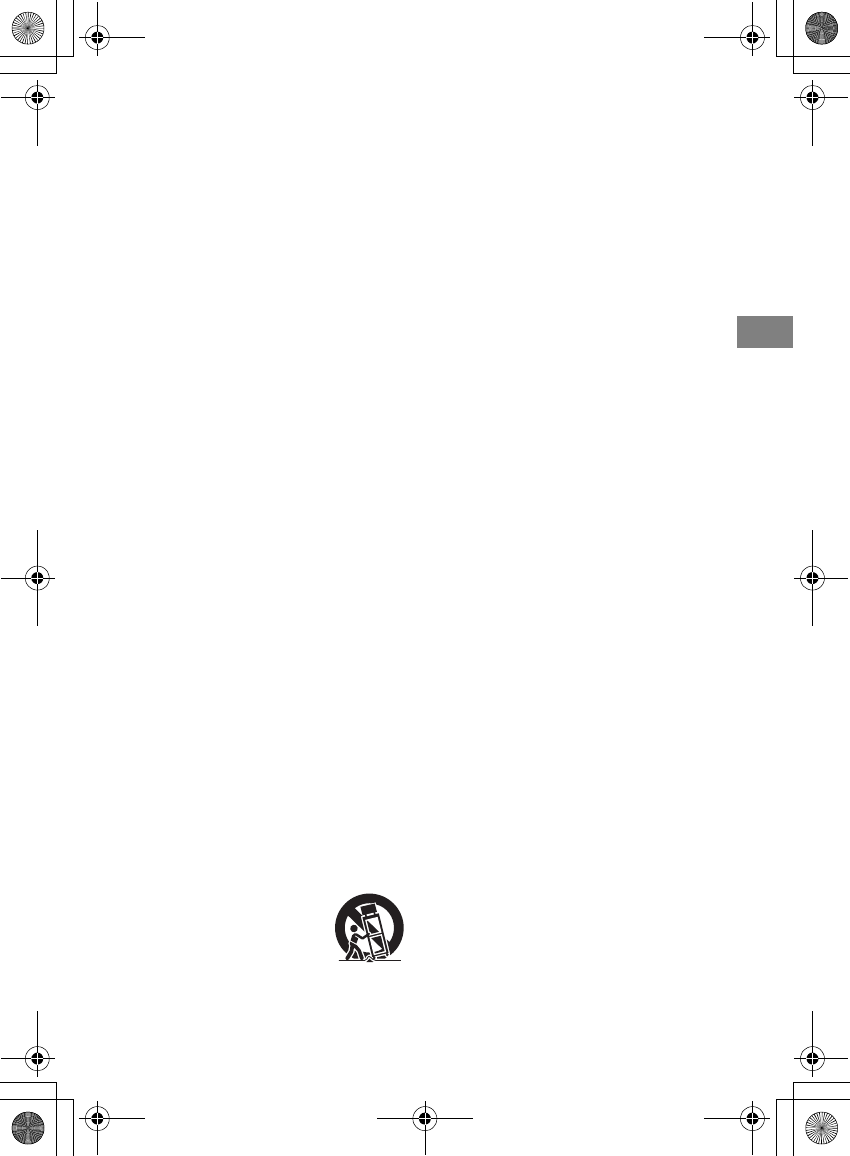
3FR
K:\081\Win7 CS\new\4727410111_HT-S100F_US-CaFR-
LaES\02FR\020REG.fm
masterpage:
Right
HT-S100F
4-727-410-11(1)
4) Respectez toutes les instructions.
5) N’utilisez pas cet appareil à
proximité de l’eau.
6) Nettoyez-le uniquement avec un
chiffon sec.
7) N’obstruez pas les orifices de
ventilation. Installez l’appareil
conformément aux instructions du
fabricant.
8) N’installez pas l’appareil à proximité
des sources de chaleur telles que les
radiateurs, les registres de chaleur,
les poêles ou autres appareils (y
compris les amplificateurs)
produisant de la chaleur.
9) N’altérez pas le dispositif de sécurité
de la fiche polarisée ou mise à la
terre. Une fiche polarisée compte
deux lames de largeur différente.
Une fiche de type mise à la terre
possède deux lames et une broche
de mise à la terre. La lame la plus
large ou la troisième broche assure
une fonction de sécurité. Si la fiche
fournie d’origine ne s’adapte pas à
votre prise, faites remplacer la prise
obsolète par un électricien.
10) Protégez le cordon d’alimentation
des lieux de passage ou des points
de pincement, en particulier au
niveau des fiches, des prises de
courant et de sa sortie de l’appareil.
11) Utilisez uniquement des accessoires
spécifiés par le fabricant.
12) Utilisez uniquement l’appareil avec
le chariot, socle, trépied, support ou
table spécifié par le fabricant ou
vendu avec l’appareil. Si vous utilisez
un chariot, soyez prudent lorsque
vous le déplacez avec l’appareil afin
d’éviter toute chute susceptible de
provoquer des blessures.
13) Débranchez cet appareil en cas
d’orage ou d’inutilisation prolongée.
14) Confiez toutes les réparations à du
personnel de service qualifié.
L’appareil doit être réparé en cas de
dommage quelconque, notamment
lorsque le cordon d’alimentation ou
sa fiche est endommagé, du liquide
ou un objet a pénétré à l’intérieur de
l’appareil, l’appareil a été exposé à la
pluie ou à l’humidité, l’appareil ne
fonctionne pas normalement ou est
tombé.
REMARQUE :
Cet appareil a été testé et s’est révélé
conforme aux limites des appareils
numériques de Classe B, conformément
à l’alinéa 15 de la réglementation FCC.
Ces limites sont conçues pour assurer
une protection raisonnable contre les
interférences nuisibles dans une
installation résidentielle. Cet appareil
génère, utilise et peut rayonner de
l’énergie de fréquence radio qui, en cas
d’installation et d’utilisation non
conformes aux instructions, peut
engendrer des interférences nuisibles
avec les communications radio.
Il n’est toutefois pas garanti qu’aucune
interférence ne surviendra dans une
installation particulière. Si cet appareil
altère effectivement la réception radio
ou télévisée, ce qui peut être déterminé
en le mettant hors tension, puis à
nouveau sous tension, nous vous
encourageons à essayer de remédier à
la situation en prenant une ou plusieurs
mesures ci-après :
– Réorientez ou repositionnez
l’antenne de réception.
– Augmentez la distance qui sépare
l’appareil du récepteur.
– Raccordez l’appareil à la prise d’un
circuit différent de celui auquel le
récepteur est raccordé.
– Sollicitez l’aide de votre revendeur ou
d’un technicien en radio/télévision
expérimenté.
FR
020REG.fm Page 3 Tuesday, September 12, 2017 2:20 PM

4FR
E:\4727410131\4727410131HTS100FUC2\02FR\020REG.fm masterpage: Left
HT-S100F
4-727-410-13(1)
Des câbles et connecteurs correctement
blindés et mis à la terre doivent être
utilisés pour le raccordement à des
ordinateurs hôtes ou des périphériques
afin de satisfaire aux limites d’émission
du FCC.
ATTENTION
Vous êtes prévenu que toute
modification ou changement non
expressément approuvé dans ce
manuel peut annuler votre autorisation
à utiliser cet appareil.
Cet appareil ne doit pas se trouver à
proximité d’un autre émetteur ou d’une
autre antenne, ou encore être utilisé en
même temps que ceux-ci.
Cet appareil est conforme aux limites
d’exposition au rayonnement de la FCC
déterminées pour un environnement
incontrôlé et répond aux
recommandations d’exposition de la
radiofréquence (RF) de la FCC. Cet
équipement présente des niveaux
d’énergie RF très bas considérés comme
conformes et ne nécessite pas
d’évaluation d’exposition maximale
admise (MPE). Il est toutefois
souhaitable de l’installer et de l’utiliser
en laissant l’appareil rayonnant à une
distance d’au moins 20cm de votre
corps.
Pour les clients au Canada
Il est impératif d’utiliser des câbles et
des connecteurs correctement blindés
et mis à la terre pour la connexion à des
ordinateurs hôtes et/ou aux
périphériques.
Le présent appareil est conforme aux
CNR d’lndustrie Canada applicables aux
appareils radio exempts de licence.
L’exploitation est autorisée aux deux
conditions suivantes :
Cet équipement est conforme aux
limites d’exposition aux rayonnements
énoncées pour un environnement non
contrôlé et respecte les règles
d’exposition aux fréquences radioé
lectriques (RF) CNR-102 de I’IC. Cet
équipement doit être installé et utilisé
en gardant une distance de 20 cm ou
plus entre le radiateur et le corps
humain (à I’exception des extrémités :
mains, poignets, pieds et chevilles).
(1) l’appareil ne doit pas produire de
brouillage ;
(2) l’utilisateur de l’appareil doit
accepter tout brouillage
radioélectrique subi, même si le
brouillage est susceptible d’en
compromettre le fonctionnement.
010COV.book Page 4 Friday, October 20, 2017 7:34 PM
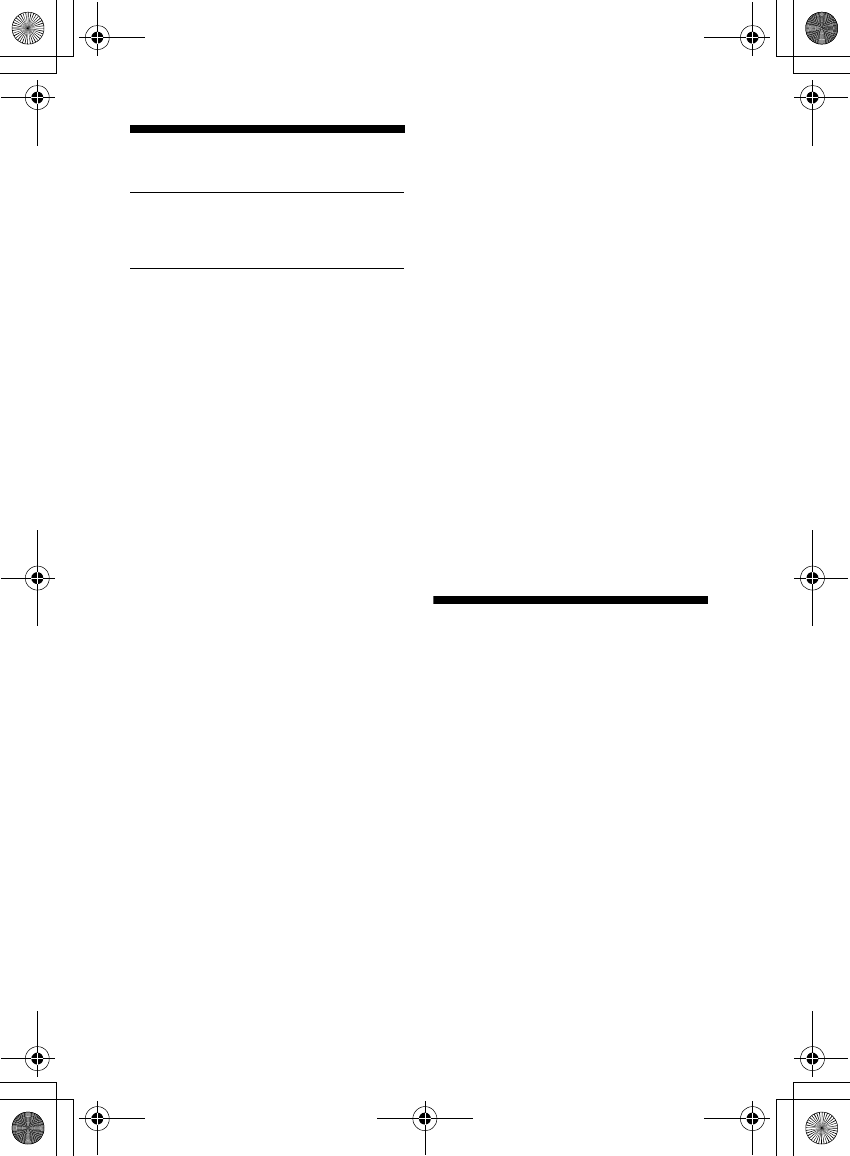
5FR
K:\081\Win7 CS\new\4727410111_HT-S100F_US-CaFR-
LaES\02FR\010COVTOC.fm
masterpage:
Right
HT-S100F
4-727-410-11(1)
Table des matières
À propos de ce manuel
d’instructions ..........................5
Que contient la boîte? ...................6
Possibilités offertes par le
système ...................................7
Guide des pièces et
commandes ............................8
Préparation pour l’utilisation
du système
Fixation de la barre de haut-parleurs
sur un mur ............................. 14
Lorsque la télécommande du
téléviseur ne fonctionne
pas ......................................... 16
Écoute du son
Écoute d’un téléviseur et d’autres
appareils .................................17
Écoute de la musique d’un
périphérique USB .................. 18
Sélection de l’effet sonore
Réglage du son ............................20
Écoute de la musique/du son
avec la fonction BLUETOOTH®
Écoute de la musique à partir d’un
appareil mobile ..................... 22
Mise en marche du système à l’aide
de l’appareil BLUETOOTH .....24
Désactivation de la fonction
BLUETOOTH ...........................24
Utilisation des diverses
fonctions
Utilisation de la fonction Contrôle
pour HDMI .............................25
Réduction de la consommation
d’énergie ............................... 27
Dépannage
Dépannage ..................................28
Réinitialisation du système .........33
Informations
complémentaires
Caractéristiques techniques ........34
Types de fichiers compatibles
(Entrée USB) ...........................36
Formats audio d’entrée pris en
charge (HDMI OUT (TV (ARC)) ou
TV IN (OPTICAL)) ....................36
À propos de la communication
BLUETOOTH ........................... 37
Précautions ..................................38
À propos de ce manuel
d’instructions
•Les instructions dans ce Manuel
d’instructions décrivent les
commandes de la télécommande.
•Certaines illustrations sont présentées
sous forme de dessins conceptuels et
peuvent différer des produits réels.
•Les réglages par défaut sont soulignés
dans chaque description de fonction.
Configuration
de base
Manuel de
démarrage
(document
distinct)
010COV.book Page 5 Thursday, September 7, 2017 11:33 AM

6FR
HT-S100F
4-727-410-12(1)
K:\081\Win7 CS\new2\4727410121_HT-S100F__US-FR-
ES\02FR\030PAC.fm
masterpage: Left
Que contient la boîte?
• Barre de haut-parleurs (1)
• Télécommande (1)
• Pile R03 (taille AAA) (2)
• Câble numérique optique (1)
• Cordon d’alimentation CA (1)
• CALIBRE DE MONTAGE MURAL (1)
• Manuel de démarrage
• Manuel d’instructions
030PAC.fm Page 6 Tuesday, October 10, 2017 11:26 AM

7FR
K:\081\Win7 CS\new\4727410111_HT-S100F_US-CaFR-
LaES\02FR\030PAC.fm
masterpage:
Right
HT-S100F
4-727-410-11(1)
Possibilités offertes par le système
« Écoute d’un téléviseur et d’autres
appareils » (page 17)
Lecteur Blu-ray Disc™, décodeur
de câblodistribution, récepteur
satellite, etc.
Raccordement du téléviseur
(reportez-vous au « Manuel de
démarrage » (document distinct))
« Utilisation de la fonction Contrôle
pour HDMI » (page 25)
« Écoute de la musique
d’un périphérique
USB » (page 18)
« Écoute de la musique à partir
d’un appareil mobile » (page 22)
010COV.book Page 7 Thursday, September 7, 2017 11:33 AM
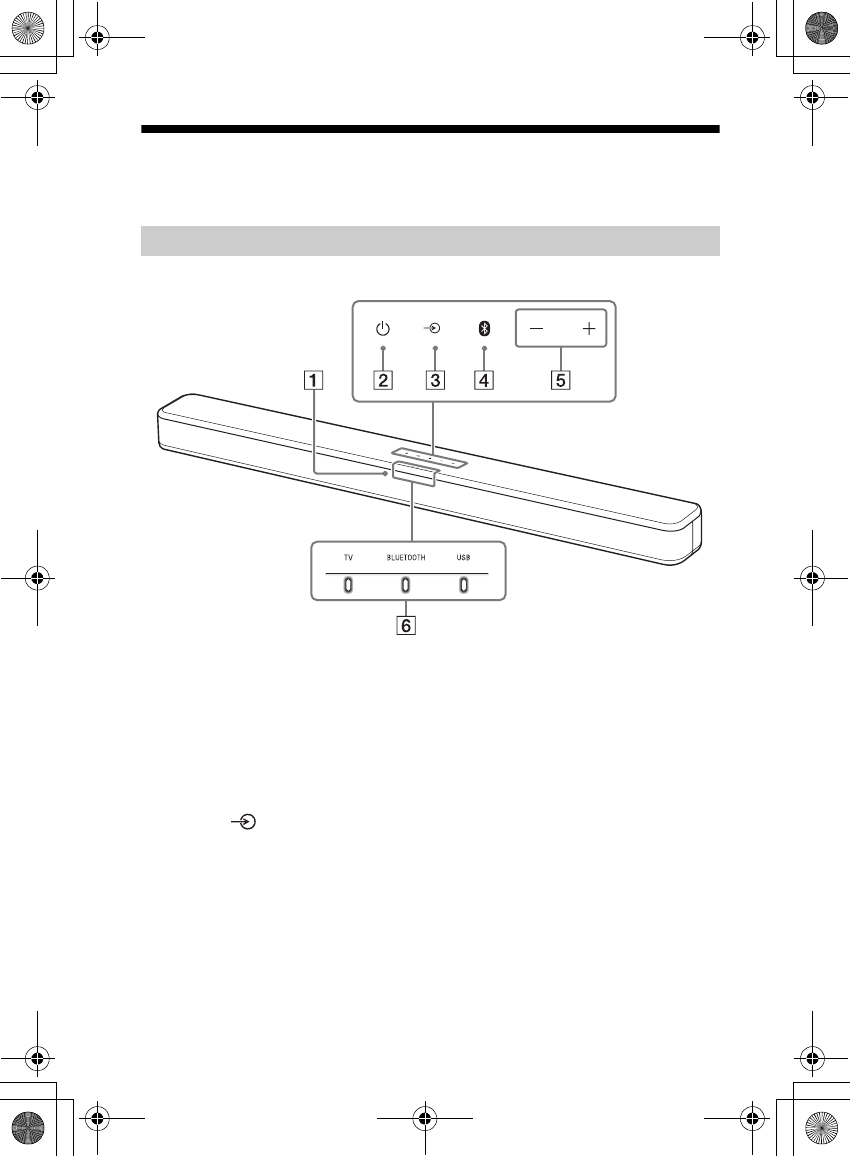
8FR
HT-S100F
4-727-410-11(1)
K:\081\Win7 CS\new\4727410111_HT-S100F_US-CaFR-
LaES\02FR\030PAC.fm
masterpage: Left
Guide des pièces et commandes
Les détails sont omis des illustrations.
Avant
Capteur de télécommande
Pointez la télécommande vers le
capteur de télécommande pour
faire fonctionner le système.
Touche (alimentation)
Allume le système ou le règle en
mode de veille.
Touche (sélection d’entrée)
(page 17)
Touche BLUETOOTH (page 22)
Touches +/– (volume)
Témoins
Pour plus de détails, consultez « À
propos des témoins de la barre de
haut-parleurs » (page 9).
Barre de haut-parleurs
010COV.book Page 8 Thursday, September 7, 2017 11:33 AM

9FR
K:\081\Win7 CS\new\4727410111_HT-S100F_US-CaFR-
LaES\02FR\030PAC.fm
masterpage:
Right
HT-S100F
4-727-410-11(1)
À propos des témoins de la barre de haut-parleurs
Un ou plusieurs témoin(s) s’allument et clignotent sur la barre de haut-parleurs pour
indiquer l’entrée ou l’état de l’appareil d’entrée.
Les témoins clignotent lors de l’activation/la désactivation du réglage de fonction ou
l’utilisation de la télécommande.
Témoins État
• S’allume : L’entrée du téléviseur est sélectionnée.
• S’allume en bleu : Connexion BLUETOOTH établie (l’entrée BLUETOOTH est
sélectionnée).
• Clignote rapidement en bleu : Pendant l’attente d’une connexion avec un
appareil.
• Clignote en bleu : Pendant la reconnexion ou l’exécution du jumelage.
• S’allume : L’entrée USB est sélectionnée.
• Clignote deux fois : Le mode de lecture est modifié.
• Clignote d’abord trois fois, puis clignote lentement à plusieurs reprises : Lors de
la connexion d’un périphérique non pris en charge.
• Clignote à plusieurs reprises : Pendant la lecture des données du périphérique
USB connecté.
Témoins État
• Clignote deux fois : L’une des fonctions suivantes est activée.
–Mode nuit (page20)
–Mode voix (page20)
• Clignote une fois : Le canal audio est réglé à Principal (page 21), le mode sonore
est sélectionné (page 20) ou l’une des fonctions suivantes est désactivée.
–Mode nuit (page20)
–Mode voix (page20)
• Clignote deux fois : L’une des fonctions suivantes est activée.
–Dolby DRC (page21)
– Contrôle pour HDMI (page 25)
– Veille BLUETOOTH (page 24)
– Fonction BLUETOOTH (page 24)
– Veille automatique (page 27)
– IR-Repeater (page 16)
• Clignote une fois : Le canal audio est réglé à Secondaire (page 21) ou l’une des
fonctions suivantes est désactivée.
–Dolby DRC (page21)
– Contrôle pour HDMI (page 25)
– Veille BLUETOOTH (page 24)
– Fonction BLUETOOTH (page 24)
– Veille automatique (page 27)
– IR-Repeater (page 16)
• Clignotent une fois : Le canal audio est réglé à Principal/Secondaire
(page 21).
• Clignotent rapidement : La fonction de protection est activée
(page 32).
• Clignotent lentement : Le système passe en mode de veille à l’aide
de la fonction de veille automatique (page 27).
010COV.book Page 9 Thursday, September 7, 2017 11:33 AM
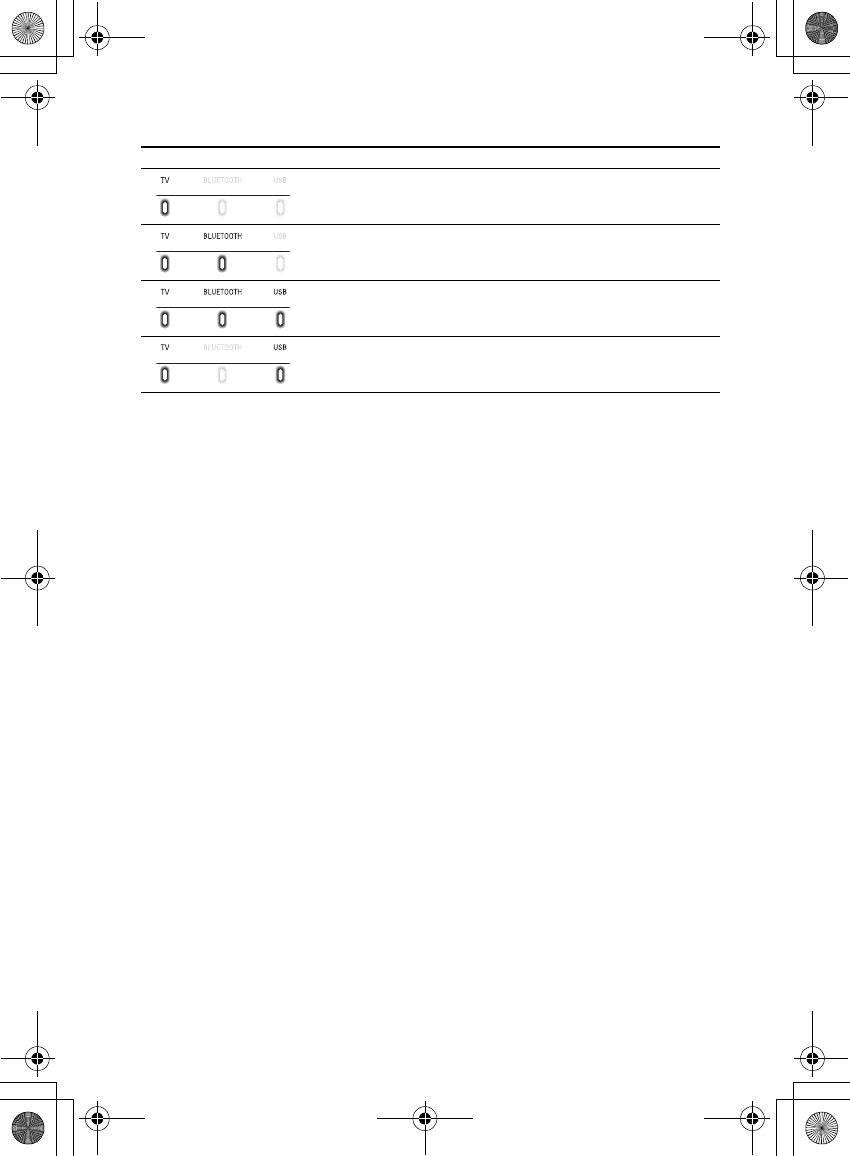
10FR
HT-S100F
4-727-410-11(1)
K:\081\Win7 CS\new\4727410111_HT-S100F_US-CaFR-
LaES\02FR\030PAC.fm
masterpage: Left
Les témoins clignotent pendant le réglage du niveau de volume.
Conseil
Vous pouvez désactiver les témoins en appuyant sur INDICATOR.
Même après la désactivation des témoins en appuyant sur INDICATOR, si vous utilisez le
système, les témoins reliés au fonctionnement s’allument ou clignotent.
Témoins État
• Clignote une fois : Le niveau de volume est faible.
• Clignotent une fois : Le niveau de volume est moyen.
• Clignotent une fois : Le niveau de volume est élevé.
• Clignotent à plusieurs reprises : Le son est coupé.
• Clignotent deux fois : Le niveau de volume est réglé au maximum/
minimum.
010COV.book Page 10 Thursday, September 7, 2017 11:33 AM
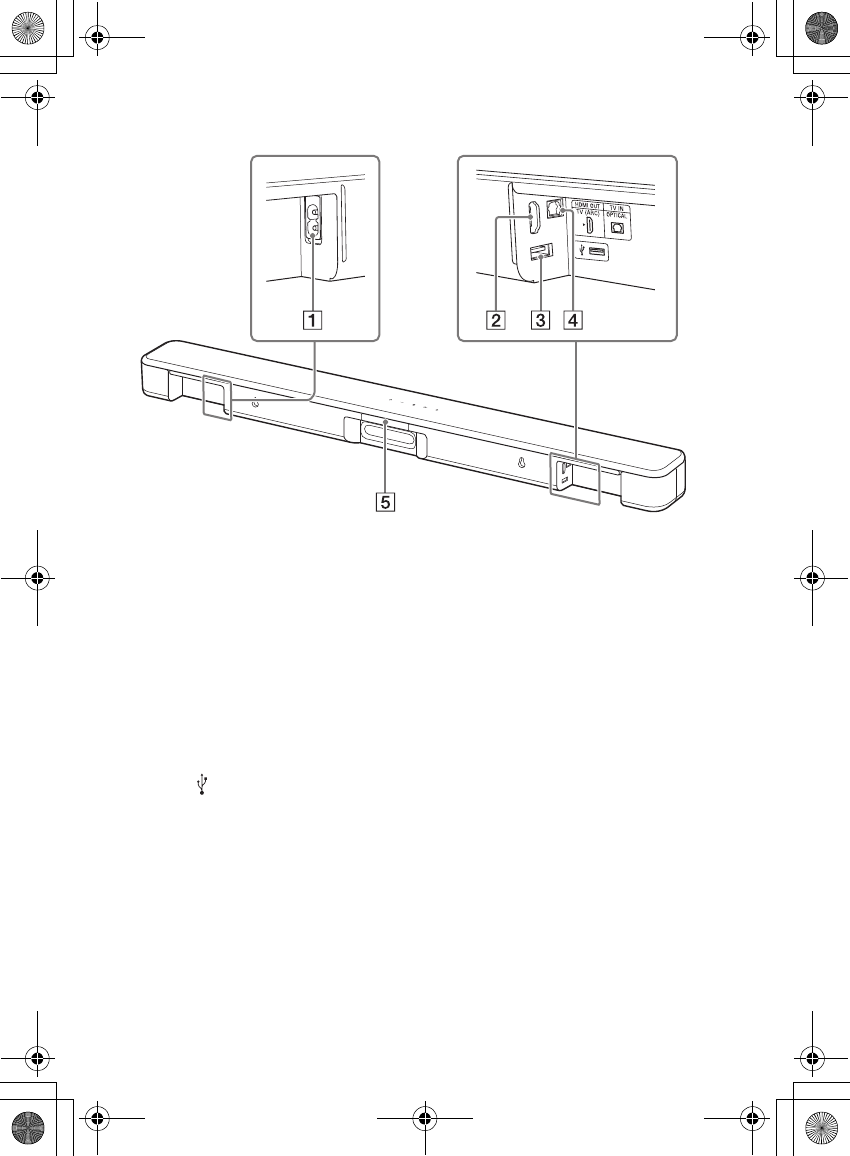
11FR
K:\081\Win7 CS\new\4727410111_HT-S100F_US-CaFR-
LaES\02FR\030PAC.fm
masterpage:
Right
HT-S100F
4-727-410-11(1)
Arrière
Borne AC IN
Prise HDMI OUT (TV (ARC))
Raccordez un téléviseur muni
d’une prise d’entrée HDMI avec
un câble HDMI.
Le système est compatible avec
Audio Return Channel (ARC). ARC
est la fonction permettant
d’envoyer le son du téléviseur à
un appareil AV, comme le
système, à partir de la prise HDMI
du téléviseur.
Port (USB) (page 18)
Prise TV IN (OPTICAL)
IR-Repeater (page 16)
Transmet le signal de la
télécommande du téléviseur au
téléviseur.
010COV.book Page 11 Thursday, September 7, 2017 11:33 AM
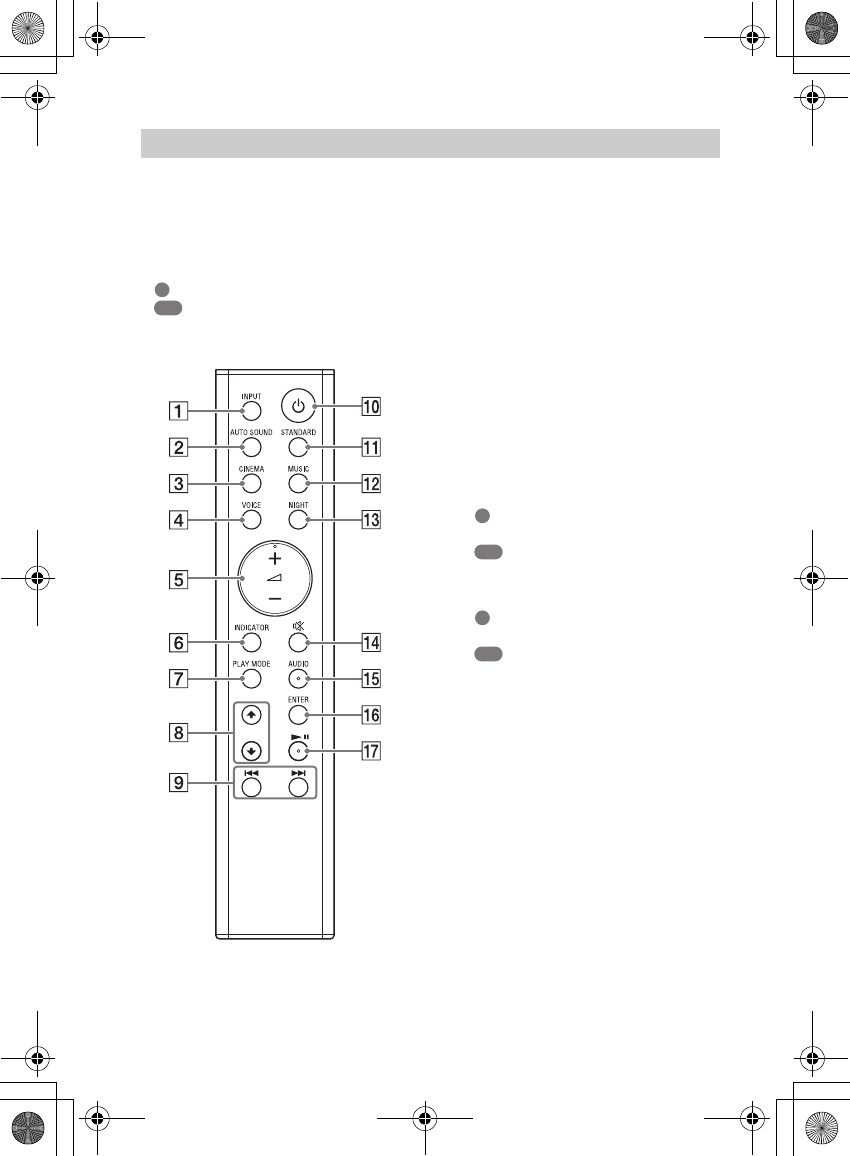
12FR
HT-S100F
4-727-410-11(1)
K:\081\Win7 CS\new\4727410111_HT-S100F_US-CaFR-
LaES\02FR\030PAC.fm
masterpage: Left
Certaines touches fonctionnent
différemment selon la durée pendant
laquelle vous appuyez sur la touche. Les
icônes ci-dessous indiquent la durée
pendant laquelle vous devez appuyer
sur la touche.
• : Appuyez sur la touche.
• : Maintenez enfoncée la touche
pendant 5 secondes.
INPUT (page 17)
Sélectionne la source de lecture.
Lorsque vous appuyez une fois sur
INPUT, le témoin de l’entrée
actuelle clignote.
Appuyez de nouveau sur INPUT
pour sélectionner l’appareil
souhaité.
Chaque fois que vous appuyez sur
INPUT, l’entrée change de manière
cyclique dans l’ordre suivant.
entrée TV entrée BLUETOOTH
entrée USB
AUTO SOUND (page 20)
Permet de sélectionner AUTO
SOUND comme effet sonore.
CINEMA
: Permet de sélectionner CINEMA
comme effet sonore. (page 20)
: Active/désactive la fonction
de veille automatique. (page 27)
VOICE
: Active/désactive le mode voix.
(page 20)
: Active/désactive la fonction
Contrôle pour HDMI. (page 25)
(volume) +*/–
Règle le volume.
INDICATOR (page 9)
Active/désactive les témoins de la
barre de haut-parleurs.
PLAY MODE (page 18)
Permet de sélectionner le mode de
lecture pour la lecture USB.
/ (page 18)
Permet de sélectionner le contenu à
l’écran du téléviseur pour la lecture
USB.
Télécommande
010COV.book Page 12 Thursday, September 7, 2017 11:33 AM
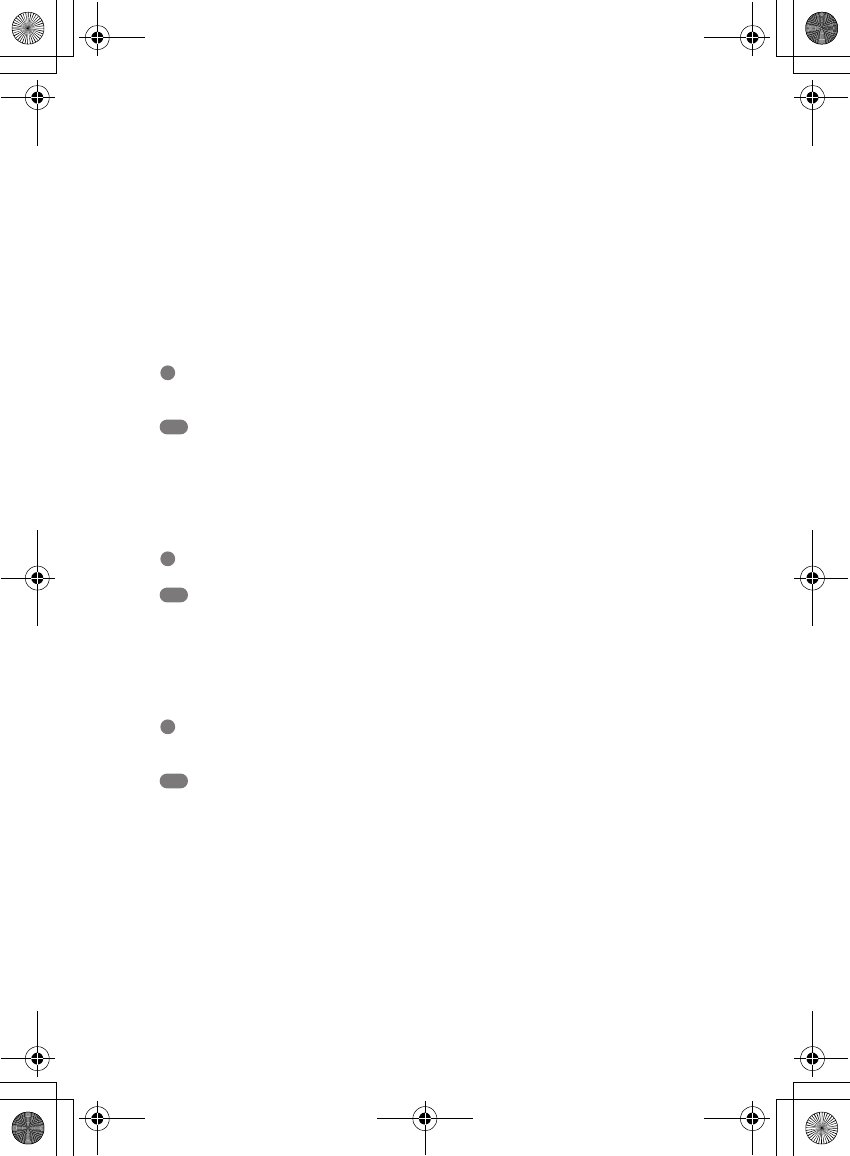
13FR
K:\081\Win7 CS\new\4727410111_HT-S100F_US-CaFR-
LaES\02FR\030PAC.fm
masterpage:
Right
HT-S100F
4-727-410-11(1)
/ (précédent/suivant)
(page 18, 22)
Appuyer brièvement sur la touche
permet d’accéder au début du
fichier précédent ou suivant.
Maintenir enfoncée la touche
permet de rechercher vers l’arrière
ou l’avant (retour/avance rapide).
(alimentation)
Allume le système ou le règle en
mode de veille.
STANDARD
: Permet de sélectionner
STANDARD comme effet sonore.
(page 20)
: Active/désactive la fonction
IR-Repeater. (page 16)
MUSIC (page 20)
Permet de sélectionner MUSIC
comme effet sonore.
NIGHT
: Active/désactive le mode nuit.
(page 20)
: Active/désactive le mode de
veille BLUETOOTH. (page 24)
(coupure du son)
Désactive temporairement le son
ou active le son.
AUDIO*
: Permet de sélectionner le canal
audio pour la diffusion en multiplex
Dolby Digital. (page 21)
: Active/désactive la fonction
Dolby DRC. (page 21)
ENTER (page 18)
Lit le contenu sélectionné par /
pour la lecture USB.
(lecture/pause)* (page 18,
22)
Suspend ou reprend la lecture.
*Les touches AUDIO, + et
comportent un point tactile. Utilisez ce
point comme guide pendant l’utilisation.
010COV.book Page 13 Thursday, September 7, 2017 11:33 AM
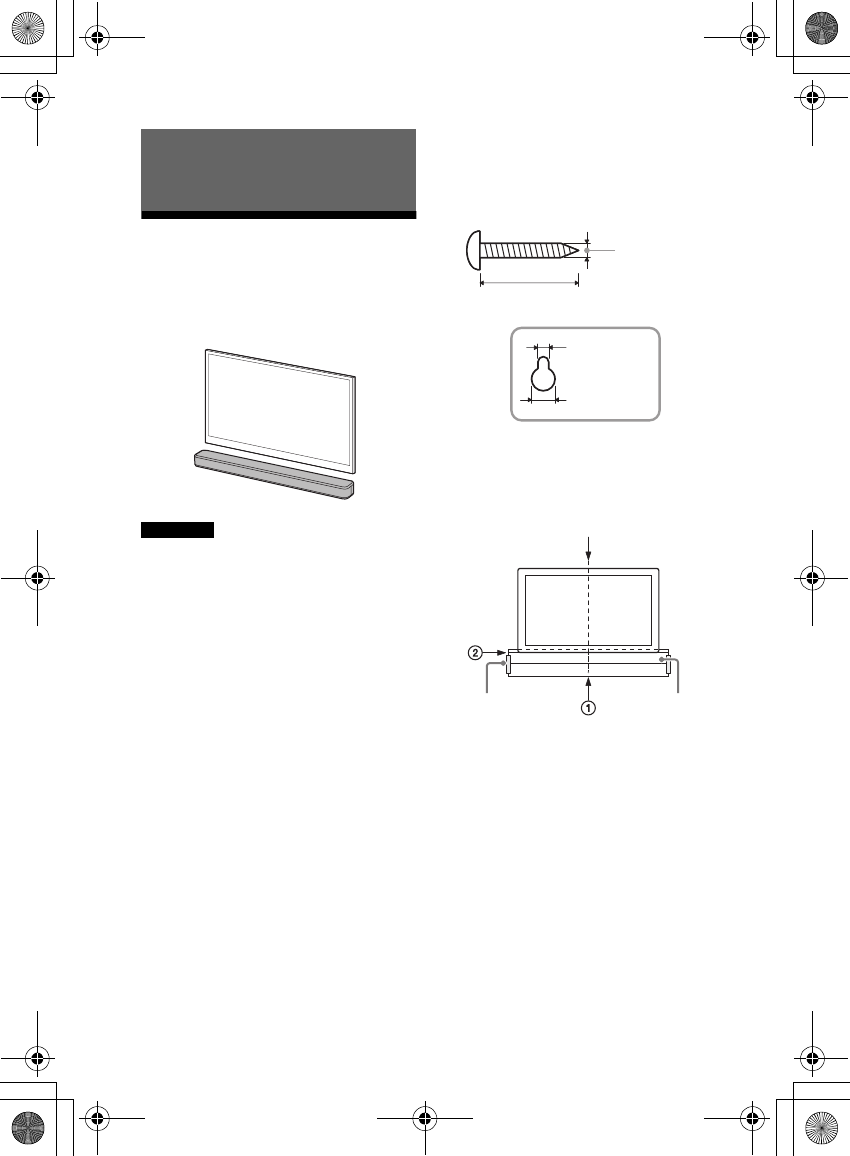
14FR
HT-S100F
4-727-410-11(1)
K:\081\Win7 CS\new\4727410111_HT-S100F_US-CaFR-
LaES\02FR\040PRE.fm
masterpage: Left
Fixation de la barre de
haut-parleurs sur un mur
Vous pouvez fixer la barre de haut-
parleurs sur un mur.
•Préparez des vis (non fournies) adaptées
au matériau et à la résistance du mur.
Comme les plaques de plâtre sont
particulièrement fragiles, fixez
fermement les vis à une poutre du mur.
Installez les enceintes à l’horizontale en
les suspendant à des vis insérées dans
des montants, sur une partie plate et
continue du mur.
• Confiez l’installation à un détaillant Sony
ou à un installateur agréé et portez une
attention particulière aux consignes de
sécurité pendant l’installation.
•Sony ne peut être tenu responsable des
accidents ou dommages occasionnés par
une installation incorrecte, une résistance
insuffisante du mur, une installation
inappropriée des vis, une catastrophe
naturelle, etc.
1Préparez deux vis (non fournies)
adaptées aux trous de fixation
murale situés à l’arrière de la
barre de haut-parleurs.
2Collez le CALIBRE DE MONTAGE
MURAL (fourni) sur le mur.
1Alignez la LIGNE CENTRALE DU
TÉLÉVISEUR () du CALIBRE DE
MONTAGE MURAL avec la ligne
centrale de votre téléviseur.
2Alignez la LIGNE ARRIÈRE DU
TÉLÉVISEUR () du CALIBRE DE
MONTAGE MURAL avec le bas de
votre téléviseur, puis collez le
CALIBRE DE MONTAGE MURAL
sur le mur en utilisant un ruban
adhésif disponible sur le marché,
etc.
Préparation pour l’utilisation du
système
Remarques
Trou à l’arrière de la barre de haut-parleurs
4mm (3/16po)
Plus de 30 mm (1 3/16 po)
5mm
(7/32 po)
10 mm
(13/32 po)
Centre du téléviseur
CALIBRE DE
MONTAGE MURAL
Ruban adhésif,
etc.
010COV.book Page 14 Thursday, September 7, 2017 11:33 AM

15FR
K:\081\Win7 CS\new\4727410111_HT-S100F_US-CaFR-
LaES\02FR\040PRE.fm
masterpage:
Right
HT-S100F
4-727-410-11(1)
3Fixez les vis dans les marques sur
la LIGNE DE VIS () du CALIBRE DE
MONTAGE MURAL de la manière
indiquée dans l’illustration ci-
dessous.
4Retirez le CALIBRE DE MONTAGE
MURAL.
5Suspendez la barre de haut-
parleurs aux vis.
Alignez les trous à l’arrière de la
barre de haut-parleurs avec les vis,
puis suspendez la barre de haut-
parleurs aux deux vis.
Au moment de coller le CALIBRE DE
MONTAGE MURAL, lissez-le
complètement.
Vis
Marques
6 mm à
7 mm
(environ
1/4 po)
228,5 mm
(9 po)
228,5 mm
(9 po)
Remarque
040PRE.fm Page 15 Tuesday, September 12, 2017 4:27 PM

16FR
HT-S100F
4-727-410-11(1)
K:\081\Win7 CS\new\4727410111_HT-S100F_US-CaFR-
LaES\02FR\040PRE.fm
masterpage: Left
Lorsque la
télécommande du
téléviseur ne fonctionne
pas
Lorsque la barre de haut-parleurs
bloque le capteur de télécommande du
téléviseur, la télécommande du
téléviseur pourrait ne pas fonctionner.
Dans ce cas, activez la fonction IR-
Repeater du système.
Vous pouvez contrôler le téléviseur à
l’aide de la télécommande du téléviseur
en envoyant le signal de télécommande
depuis l’arrière de la barre de haut-
parleurs.
Maintenez enfoncée la touche
STANDARD pendant 5 secondes pour
activer ou désactiver la fonction.
•Assurez-vous que la télécommande du
téléviseur ne peut pas contrôler le
téléviseur, puis activez la fonction IR-
Repeater. Si la fonction est activée
pendant que la télécommande peut
contrôler le téléviseur, un problème de
fonctionnement peut survenir en raison
des interférences entre la commande
directe de la télécommande et la
commande via la barre de haut-parleurs.
•Sur certains téléviseurs, cette fonction
pourrait ne pas fonctionner
correctement. Dans ce cas, éloignez
légèrement la barre de haut-parleurs du
téléviseur.
Fonction IR-Repeater activée
Le témoin USB clignote deux fois.
Fonction IR-Repeater désactivée
Le témoin USB clignote une fois.
Remarques
010COV.book Page 16 Thursday, September 7, 2017 11:33 AM
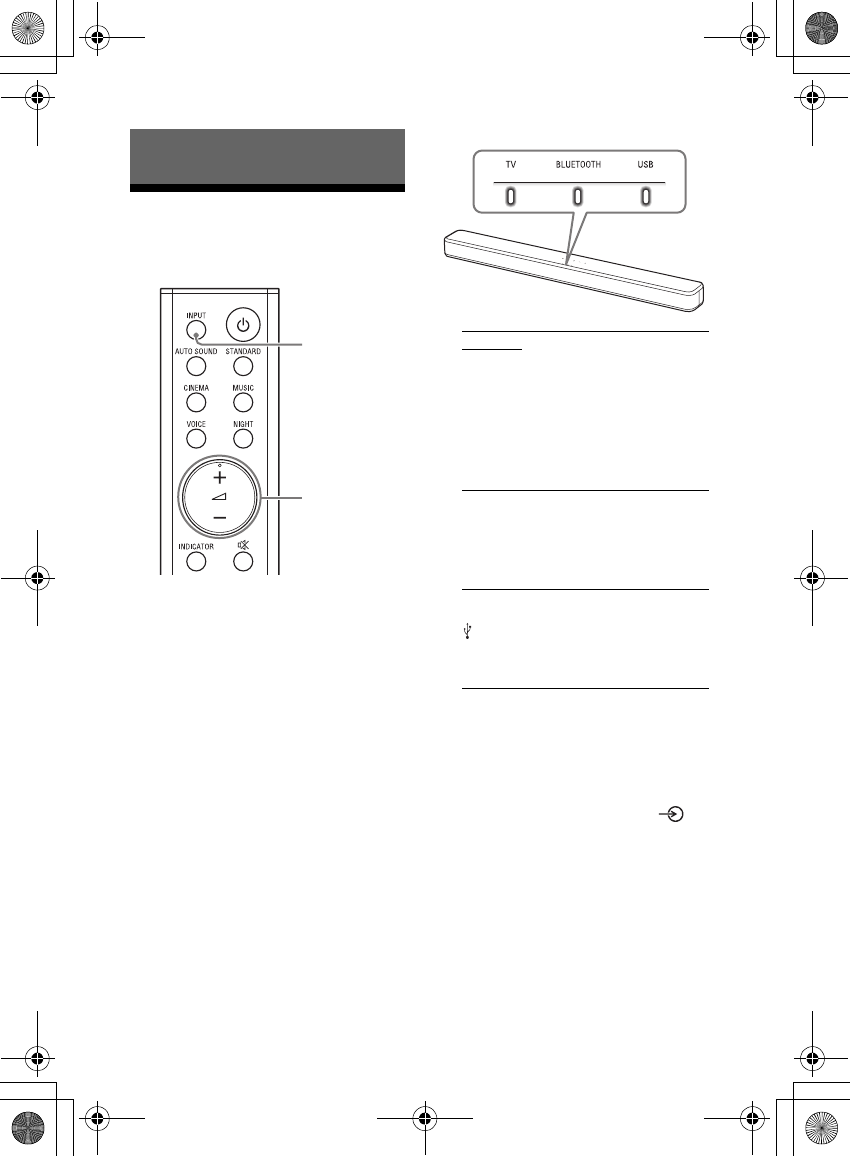
17FR
K:\081\Win7 CS\new\4727410111_HT-S100F_US-CaFR-
LaES\02FR\050LST.fm
masterpage:
Right
HT-S100F
4-727-410-11(1)
Écoute d’un téléviseur et
d’autres appareils
1Appuyez plusieurs fois sur INPUT.
Lorsque vous appuyez une fois sur
INPUT, le témoin de l’entrée
actuelle clignote.
Appuyez de nouveau sur INPUT
pour sélectionner l’appareil
souhaité.
Le témoin de l’appareil sélectionné
s’allume.
Chaque fois que vous appuyez sur
INPUT, l’entrée change de manière
cyclique dans l’ordre suivant.
entrée TV entrée BLUETOOTH
entrée USB
2Réglez le volume en appuyant sur
la touche +/– de la
télécommande.
Conseil
Vous pouvez également sélectionner
l’entrée en appuyant sur la touche de
la barre de haut-parleurs.
Écoute du son
INPUT
+/–
Entrée TV
• Téléviseur connecté à la prise TV IN
(OPTICAL)
• Téléviseur compatible avec la fonction
Audio Return Channel (ARC) connecté
à la prise HDMI OUT (TV (ARC))
Lorsque vous raccordez le téléviseur aux
prises HDMI OUT (TV (ARC)) et TV IN
(OPTICAL), le signal d’entrée de la prise
HDMI OUT (TV (ARC)) a la priorité.
Entrée BLUETOOTH
Appareil BLUETOOTH prenant en charge
A2DP
Pour plus de détails, consultez « Écoute
de la musique/du son avec la fonction
BLUETOOTH® » (page 22).
Entrée USB
Périphérique USB connecté au port
(USB)
Pour plus de détails, consultez « Écoute
de la musique d’un périphérique USB »
(page 18).
010COV.book Page 17 Thursday, September 7, 2017 11:33 AM
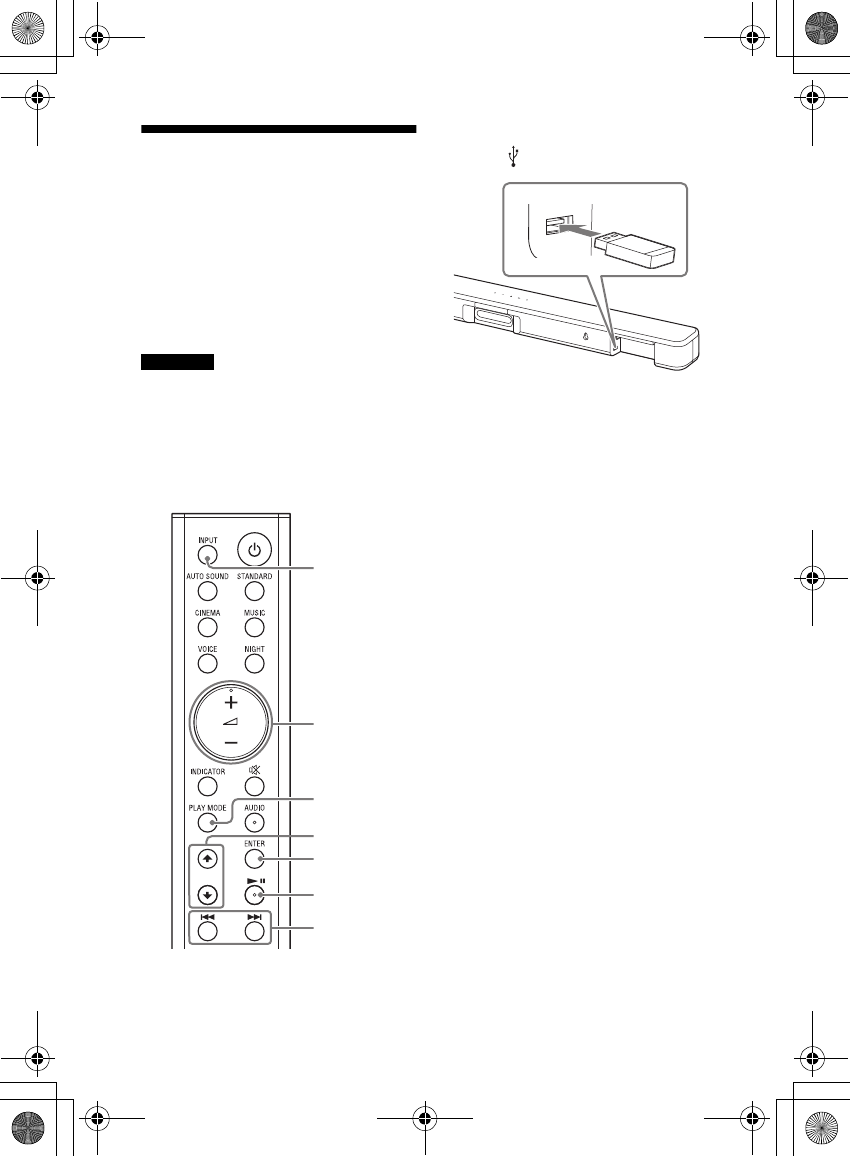
18FR
HT-S100F
4-727-410-11(1)
K:\081\Win7 CS\new\4727410111_HT-S100F_US-CaFR-
LaES\02FR\050LST.fm
masterpage: Left
Écoute de la musique
d’un périphérique USB
Vous pouvez lire des fichiers de
musique stockés sur un périphérique
USB connecté.
Pour connaître les différents types de
fichiers compatibles, consultez « Types
de fichiers compatibles (Entrée USB) »
(page 36).
•Pour afficher la liste de contenus USB à
l’écran du téléviseur, assurez-vous de
raccorder le système au téléviseur en
utilisant un câble HDMI.
•Changez l’entrée du téléviseur à l’entrée
à laquelle la barre de haut-parleurs est
raccordée.
1Connectez le périphérique USB au
port (USB).
2Appuyez plusieurs fois sur INPUT
pour sélectionner l’entrée USB.
Le témoin USB s’allume et la liste de
contenus USB apparaît à l’écran du
téléviseur.
3Appuyez sur / pour
sélectionner le contenu souhaité,
puis appuyez sur ENTER.
La lecture du contenu sélectionné
démarre.
4Appuyez plusieurs fois sur PLAY
MODE pour sélectionner le mode
de lecture souhaité.
• Aucun : Lit toutes les plages.
• [Repeat One] : Répète une plage.
• [Repeat Folder] : Répète toutes les
plages d’un dossier.
• [Shuffle] : Répète toutes les
plages d’un dossier dans un ordre
aléatoire.
Le témoin USB clignote deux fois
chaque fois que vous appuyez sur
PLAY MODE.
5Réglez le volume en appuyant sur
la touche +/– de la
télécommande.
Remarques
ENTER
PLAY MODE
+/–
/
INPUT
/
050LST.fm Page 18 Tuesday, September 12, 2017 2:21 PM

19FR
K:\081\Win7 CS\new\4727410111_HT-S100F_US-CaFR-
LaES\02FR\050LST.fm
masterpage:
Right
HT-S100F
4-727-410-11(1)
Autres opérations
•Ne retirez pas le périphérique USB
pendant l’utilisation. Pour éviter toute
corruption ou tout endommagement des
données sur le périphérique USB,
éteignez le système avant de connecter
ou retirer le périphérique USB.
• Le témoin USB clignote d’abord trois fois,
puis clignote lentement à plusieurs
reprises si vous connectez un
périphérique USB non pris en charge.
• Selon le format de fichier, le retour et
l’avance rapide pourraient ne pas
fonctionner.
Durée de lecture
Durée de lecture totale
Index du fichier sélectionné/Nombre
total de fichiers dans le dossier
Mode de lecture
État de lecture
Vitesse de retour/avance rapide
Les messages suivants apparaissent à
l’écran du téléviseur selon l’état du
périphérique USB.
•[No USB]
Aucune périphérique USB n’est inséré.
•[Waiting]
Le système recherche un périphérique
USB.
• Selon la source de lecture, certaines
informations pourraient ne pas s’afficher.
• Selon le mode de lecture, les informations
affichées pourraient être différentes.
Pour Action
Suspendre ou
reprendre la lecture Appuyez sur
.
Sélectionner la plage
précédente ou
suivante
Appuyez sur
/.
Rechercher vers
l’arrière ou l’avant
(retour/avance rapide)
Maintenez
enfoncée la
touche /
.
Remarques
Informations du
périphérique USB à l’écran
du téléviseur
Remarques
010COV.book Page 19 Thursday, September 7, 2017 11:33 AM

20FR
HT-S100F
4-727-410-11(1)
K:\081\Win7 CS\new\4727410111_HT-S100F_US-CaFR-
LaES\02FR\060SOU.fm
masterpage: Left
Réglage du son
Vous pouvez facilement profiter des
effets sonores préprogrammés adaptés
à différents types de sources sonores.
Appuyez sur AUTO SOUND, CINEMA,
MUSIC ou STANDARD pour
sélectionner le mode sonore.
Lors de la sélection du mode sonore, le témoin
TV clignote une fois.
Vous pouvez compresser le son en
fonction des informations comprises
dans le contenu en activant le mode
nuit.
Le son est émis à un volume faible avec
une perte minimale de fidélité et de
clarté des dialogues.
Appuyez sur NIGHT pour activer ou
désactiver la fonction.
Lorsque vous éteignez le système, le mode
nuit est automatiquement désactivé.
Vous pouvez améliorer la clarté des
dialogues en activant le mode voix.
Appuyez sur VOICE pour activer ou
désactiver la fonction.
Sélection de l’effet sonore
Apprécier l’effet sonore
adapté aux sources sonores
(Mode sonore)
AUTO SOUND
Vous pouvez apprécier le son avec le mode
sonore recommandé par Sony. Le mode
sonore est automatiquement optimisé en
fonction du contenu en cours de lecture et de
la fonction.
CINEMA
Les sonorités sont émises avec des effets
ambiophoniques, réalistes et puissants, afin
qu’elles soient adaptées aux films.
MUSIC
Les effets sonores sont optimisés pour
l’écoute de la musique.
STANDARD
AUTO SOUND
MUSIC
CINEMA
STANDARD
Les effets sonores sont optimisés pour la
source individuelle.
Apprécier un son clair avec
un volume faible pendant la
nuit (NIGHT)
Mode nuit activé
Le témoin TV clignote deux fois.
Mode nuit désactivé
Le témoin TV clignote une fois.
Remarque
Améliorer la clarté des
dialogues (VOICE)
Mode voix activé
Le témoin TV clignote deux fois.
Mode voix désactivé
Le témoin TV clignote une fois.
010COV.book Page 20 Thursday, September 7, 2017 11:33 AM
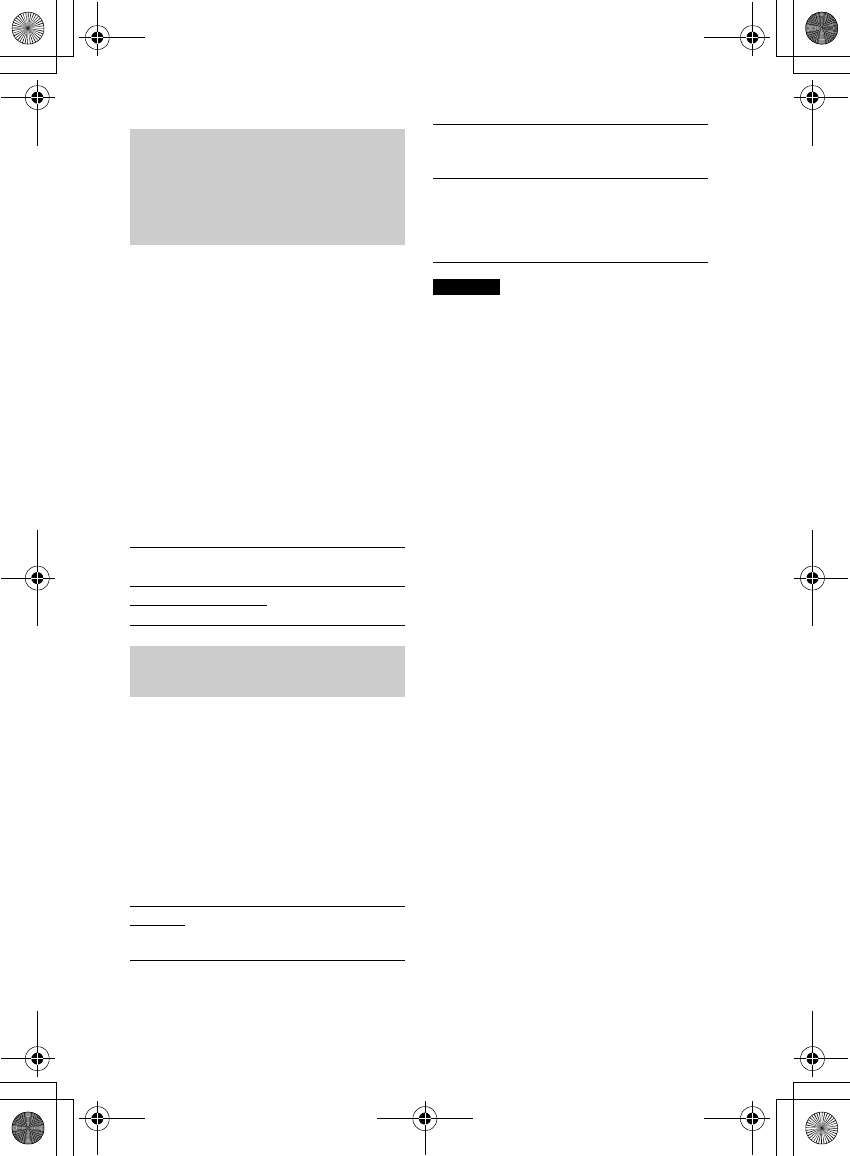
21FR
K:\081\Win7 CS\new\4727410111_HT-S100F_US-CaFR-
LaES\02FR\060SOU.fm
masterpage:
Right
HT-S100F
4-727-410-11(1)
Cette fonction fonctionne uniquement
lors de la lecture du signal Dolby Digital
de l’appareil connecté à la prise TV IN
(OPTICAL)/HDMI OUT (TV (ARC)).
Lorsque vous activez Dolby DRC
(Contrôle de la gamme dynamique), la
gamme dynamique du signal audio (la
différence entre les niveaux de volume
minimum et maximum) est compressée
et les sons à faible volume sont faciles à
entendre.
Maintenez enfoncée la touche AUDIO
pendant 5 secondes pour activer ou
désactiver la fonction.
Vous pouvez apprécier un son diffusé
en multiplex lorsque le système reçoit
un signal diffusé en multiplex Dolby
Digital.
Appuyez plusieurs fois sur AUDIO.
Le canal change de manière cyclique
dans l’ordre suivant.
Principal Secondaire Principal/
Secondaire
Pour recevoir un signal Dolby Digital, vous
devez raccorder un téléviseur ou d’autres
appareils à la prise TV IN (OPTICAL) à l’aide
du câble numérique optique (fourni) ou à la
prise HDMI OUT (TV (ARC)) à l’aide d’un
câble HDMI (non fourni).
Rendre les sons à faible
volume plus faciles à
entendre grâce à la
compression de la gamme
dynamique
Dolby DRC activée
Le témoin USB clignote deux fois.
Dolby DRC désactivée
Le témoin USB clignote une fois.
Apprécier un son diffusé en
multiplex (AUDIO)
Principal
Émet uniquement le canal principal.
Le témoin TV clignote une fois.
Secondaire
Émet uniquement le canal secondaire.
Le témoin USB clignote une fois.
Principal/Secondaire
Le son principal est émis par le haut-parleur
gauche et le son secondaire par le haut-
parleur droit.
Les témoins TV et USB clignotent une fois.
Remarque
010COV.book Page 21 Thursday, September 7, 2017 11:33 AM
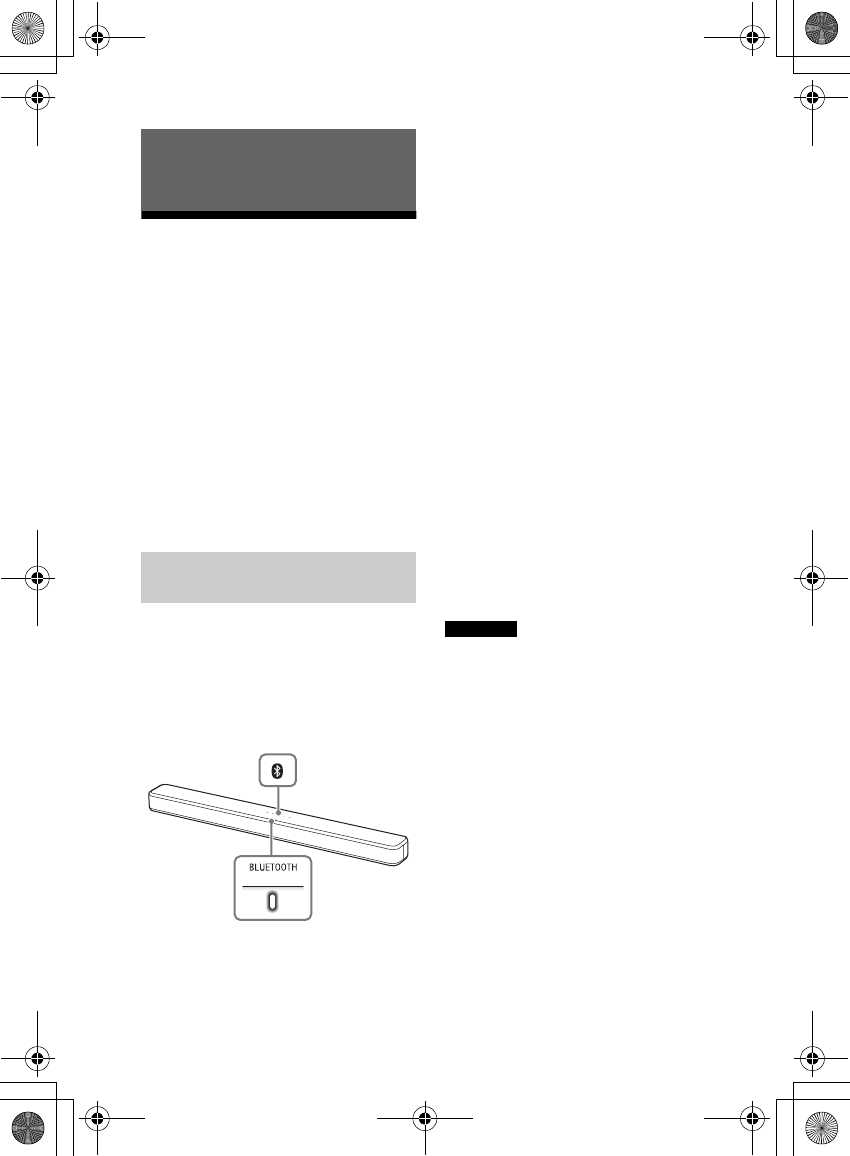
22FR
HT-S100F
4-727-410-11(1)
K:\081\Win7 CS\new\4727410111_HT-S100F_US-CaFR-
LaES\02FR\070BTF.fm
masterpage: Left
Écoute de la musique à
partir d’un appareil
mobile
Vous pouvez écouter la musique
stockée sur un appareil mobile tel qu’un
téléphone intelligent ou une tablette via
une connexion sans fil en connectant le
système et l’appareil mobile avec la
fonction BLUETOOTH.
Lors de la connexion de l’appareil
mobile avec la fonction BLUETOOTH,
vous pouvez le faire fonctionner en
utilisant simplement la télécommande
fournie, sans allumer le téléviseur.
1Maintenez enfoncée la touche
BLUETOOTH de la barre de haut-
parleurs pendant 5 secondes.
Le système passe en mode de
jumelage et le témoin BLUETOOTH
clignote rapidement.
2Sur l’appareil mobile, activez la
fonction BLUETOOTH, puis
sélectionnez « HT-S100F » après
l’avoir recherché.
Si un code est demandé, entrez
« 0000 ».
3Assurez-vous que le témoin
BLUETOOTH de la barre de haut-
parleurs s’allume en bleu.
Une connexion est établie entre le
système et l’appareil mobile.
4Démarrez la lecture audio avec
l’application musicale sur
l’appareil mobile connecté.
Le son est émis par la barre de haut-
parleurs.
5Réglez le volume.
• Réglez le volume en appuyant sur
la touche +/– de la
télécommande.
• Les touches et / de
la télécommande peuvent être
utilisées pour la fonction
BLUETOOTH.
•Vous pouvez jumeler jusqu’à 8 appareils
BLUETOOTH. Si un 9e appareil
BLUETOOTH est jumelé, l’appareil
connecté le moins récemment sera
remplacé par le nouveau.
• Effectuez le jumelage pour le deuxième
appareil mobile et les suivants.
Conseils
•Vous pouvez vérifier l’état de connexion
de la fonction BLUETOOTH en vérifiant
l’état du témoin BLUETOOTH (page 9).
•Pendant que l’entrée BLUETOOTH est
sélectionnée, le système passe en mode
de jumelage lorsque vous appuyez
brièvement sur la touche BLUETOOTH de
la barre de haut-parleurs.
Écoute de la musique/du son avec
la fonction BLUETOOTH®
Écoute de la musique en
jumelant un appareil mobile
Témoin
BLUETOOTH
Touche
BLUETOOTH
Remarques
010COV.book Page 22 Thursday, September 7, 2017 11:33 AM

23FR
K:\081\Win7 CS\new\4727410111_HT-S100F_US-CaFR-
LaES\02FR\070BTF.fm
masterpage:
Right
HT-S100F
4-727-410-11(1)
1Activez la fonction BLUETOOTH de
l’appareil mobile.
2Appuyez plusieurs fois sur INPUT
pour sélectionner l’entrée
BLUETOOTH ou appuyez
brièvement sur la touche
BLUETOOTH de la barre de haut-
parleurs.
Le témoin BLUETOOTH clignote et le
système se reconnecte
automatiquement à l’appareil
BLUETOOTH auquel il était connecté
le plus récemment.
3Assurez-vous que le témoin
BLUETOOTH s’allume en bleu.
Une connexion est établie entre le
système et l’appareil mobile.
4Démarrez la lecture audio avec
l’application musicale sur
l’appareil mobile connecté.
Le son est émis par la barre de haut-
parleurs.
5Réglez le volume.
• Réglez le volume en appuyant sur
la touche +/– de la
télécommande.
• Les touches et / de
la télécommande peuvent être
utilisées pour la fonction
BLUETOOTH.
Écoute de la musique à partir
de l’appareil mobile jumelé
INPUT
+/–
/
010COV.book Page 23 Thursday, September 7, 2017 11:33 AM

24FR
HT-S100F
4-727-410-11(1)
K:\081\Win7 CS\new\4727410111_HT-S100F_US-CaFR-
LaES\02FR\070BTF.fm
masterpage: Left
Mise en marche du
système à l’aide de
l’appareil BLUETOOTH
Lorsque le système contient des
informations de jumelage, vous pouvez
allumer le système et écouter la
musique d’un appareil BLUETOOTH,
même si le système est en mode de
veille, en activant le mode de veille
BLUETOOTH.
Maintenez enfoncée la touche NIGHT
pendant 5 secondes pour activer ou
désactiver la fonction.
Pendant que le mode de veille BLUETOOTH
est activé, la consommation d’énergie en
mode de veille augmente.
Désactivation de la
fonction BLUETOOTH
Vous pouvez désactiver la fonction
BLUETOOTH.
Maintenez enfoncées les touches ,
et – de la barre de haut-parleurs
pendant 10 secondes pour activer ou
désactiver la fonction.
Lorsque la fonction BLUETOOTH est
désactivée, l’entrée BLUETOOTH est
ignorée lors de la sélection de l’entrée en
appuyant sur INPUT.
Mode de veille BLUETOOTH activé
Le témoin USB clignote deux fois.
Mode de veille BLUETOOTH désactivé
Le témoin USB clignote une fois.
Remarque
Fonction BLUETOOTH activée
Le témoin USB clignote deux fois.
Fonction BLUETOOTH désactivée
Le témoin USB clignote une fois.
Remarque
010COV.book Page 24 Thursday, September 7, 2017 11:33 AM